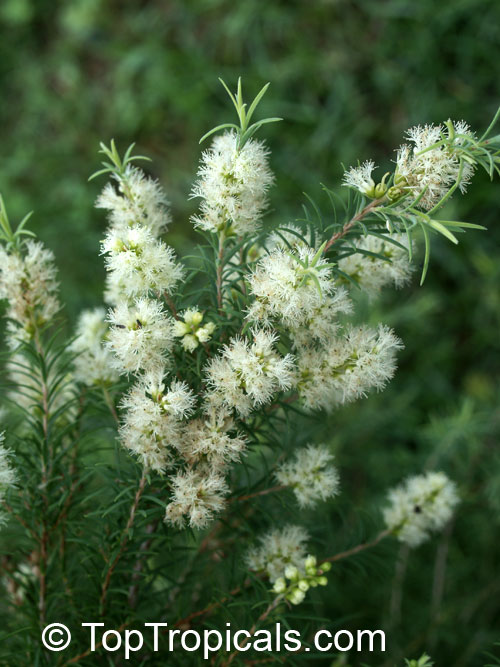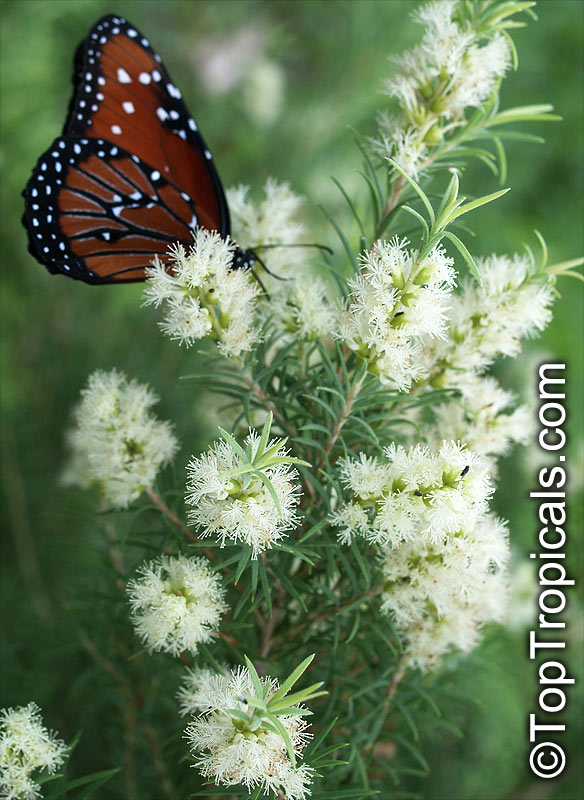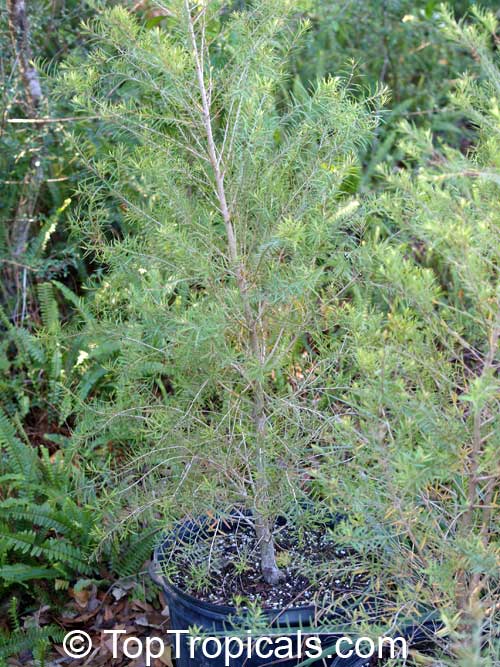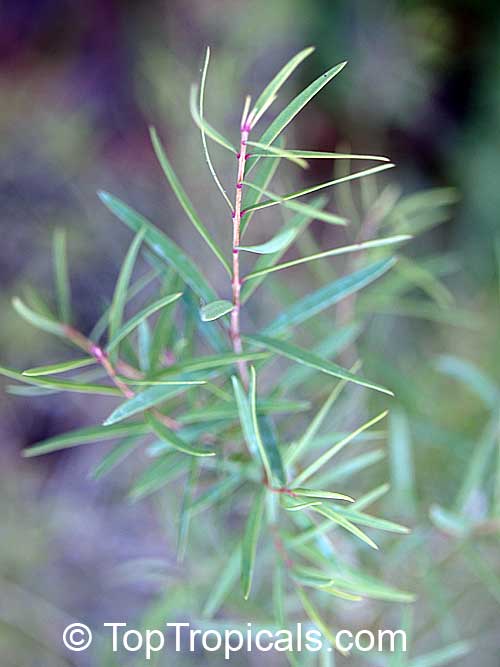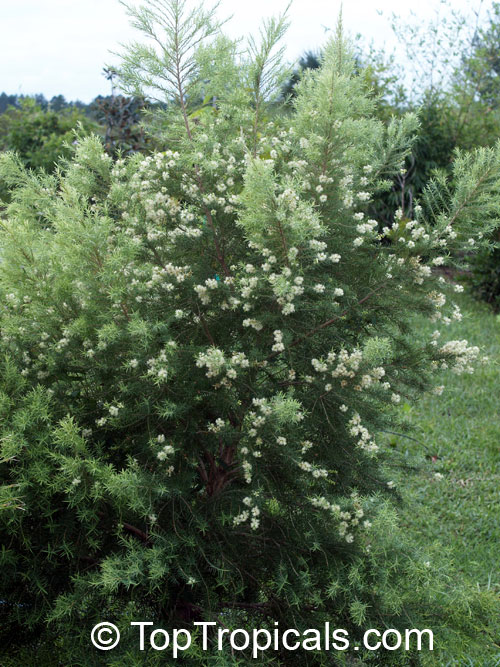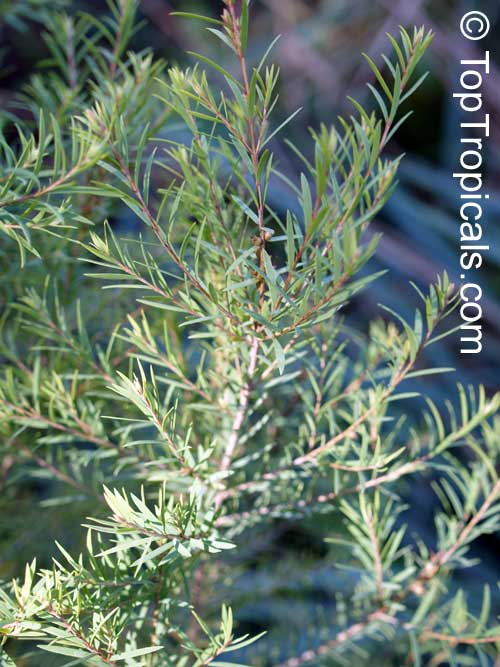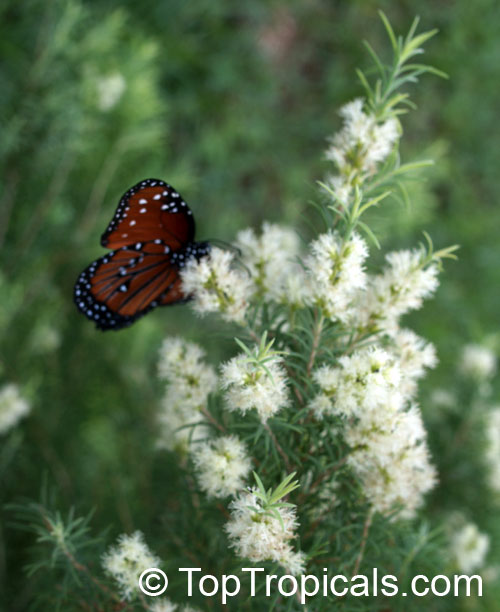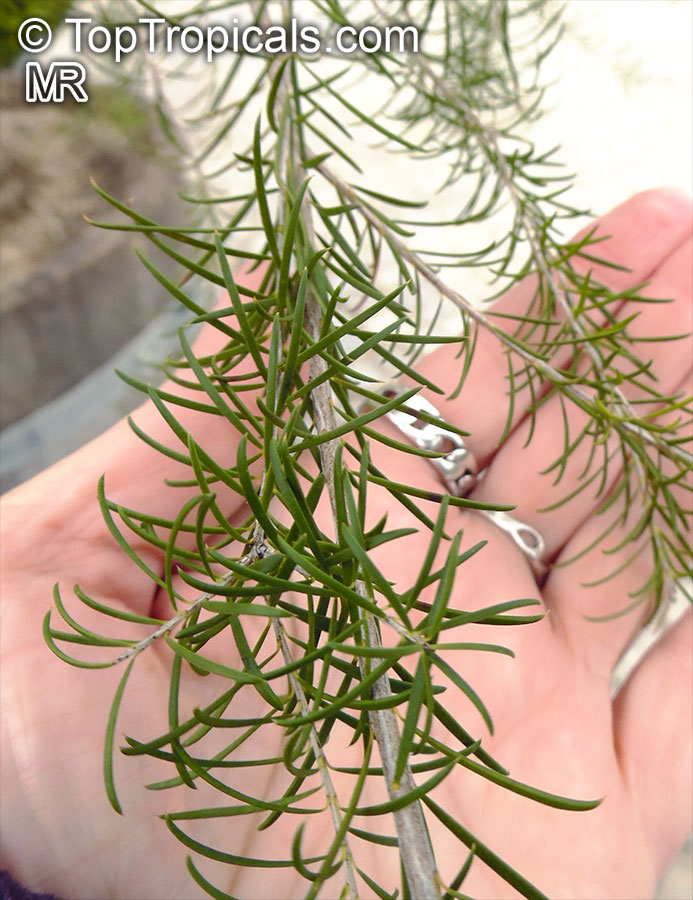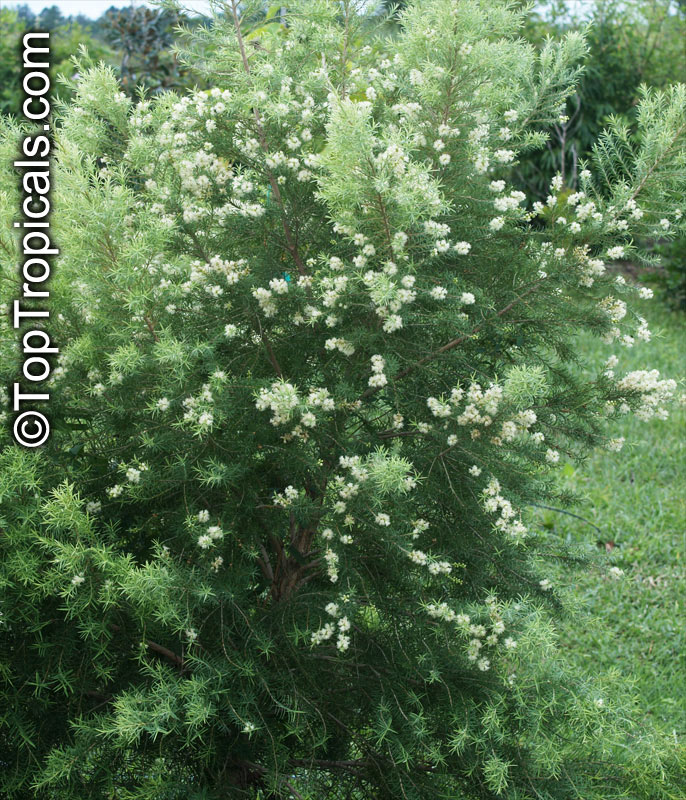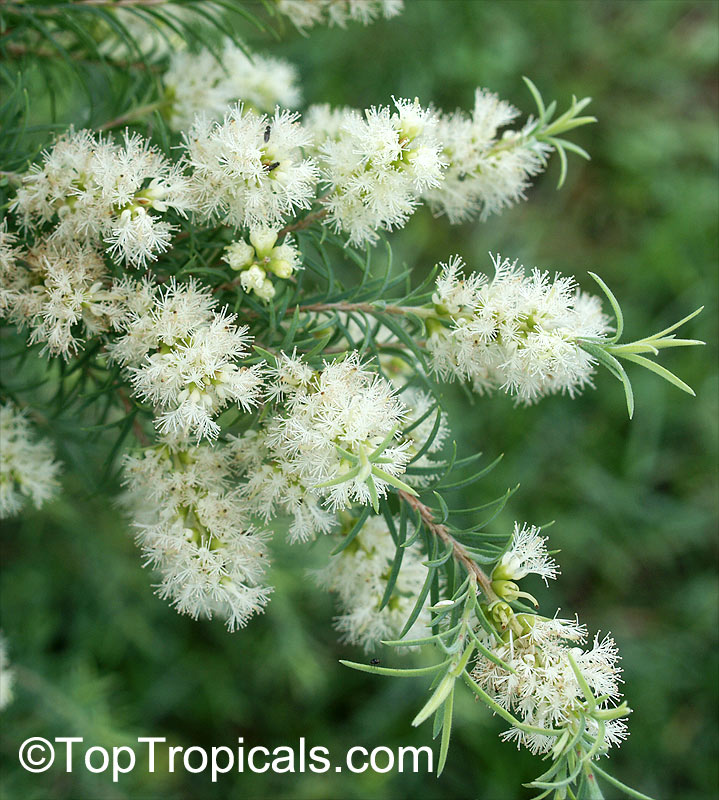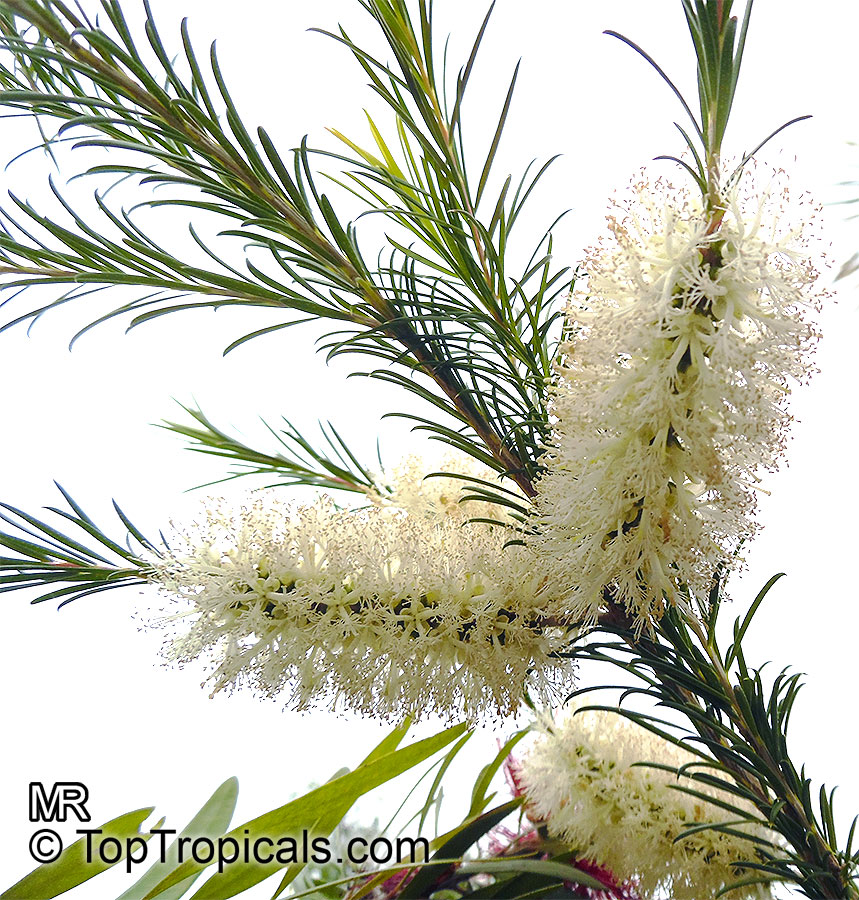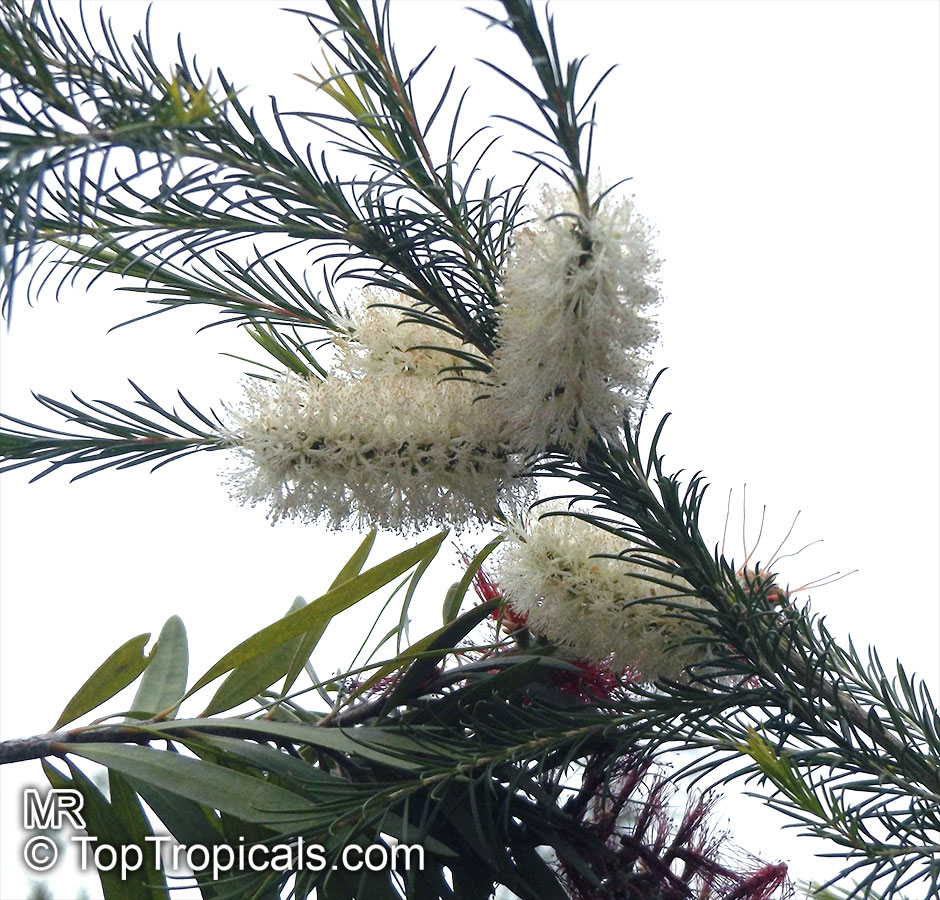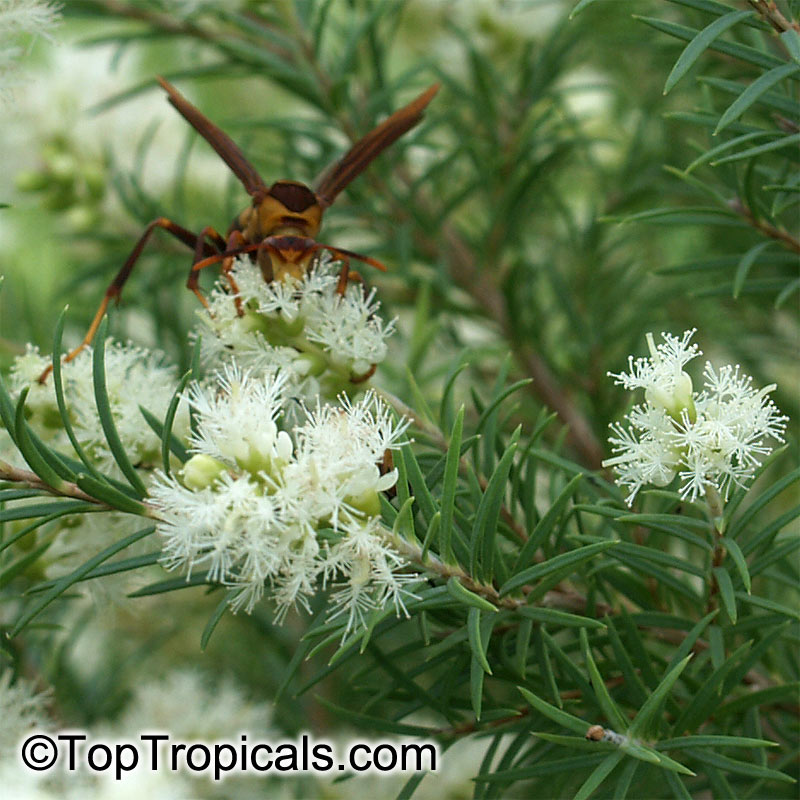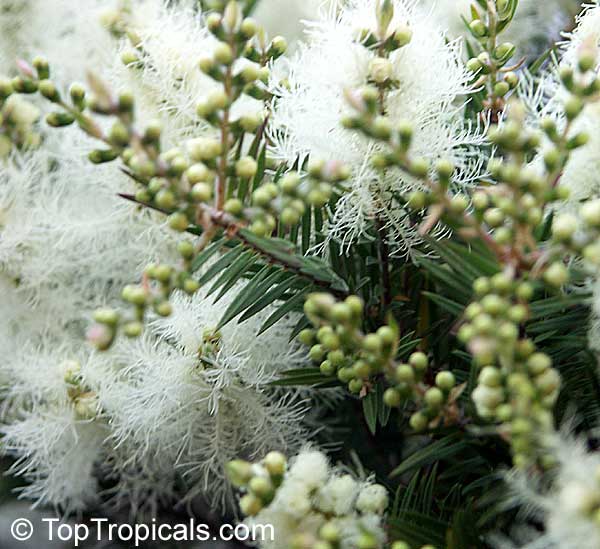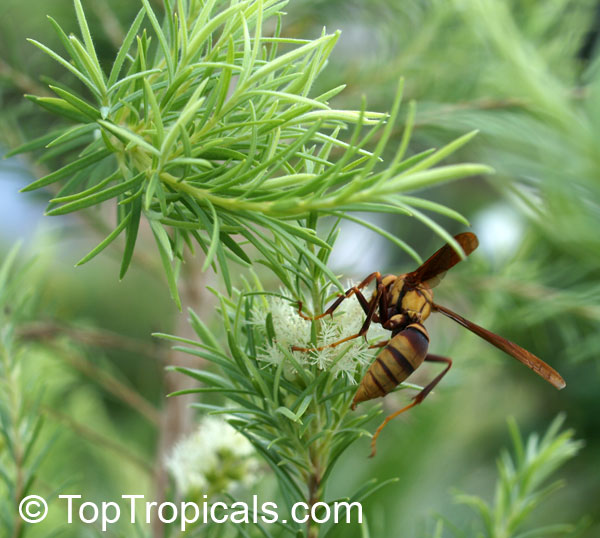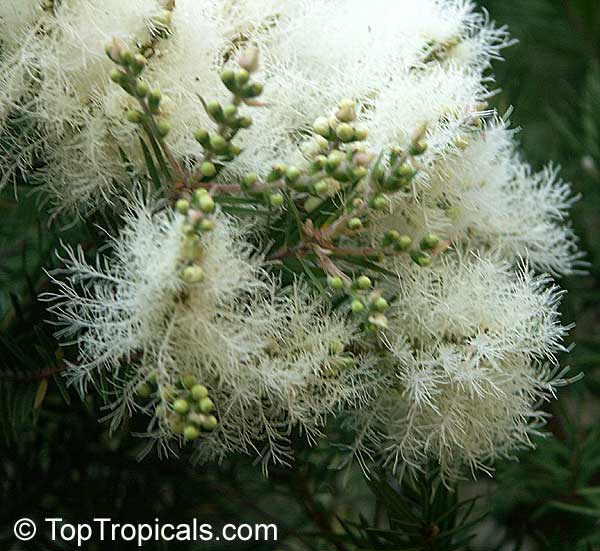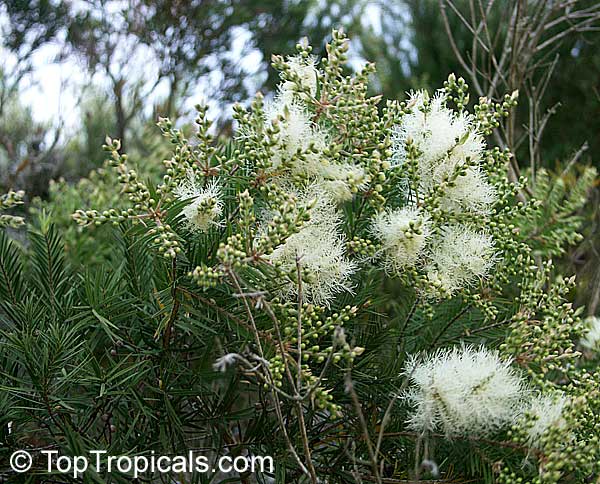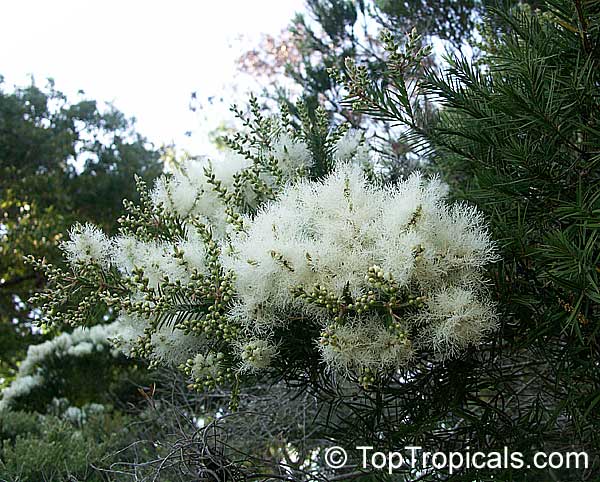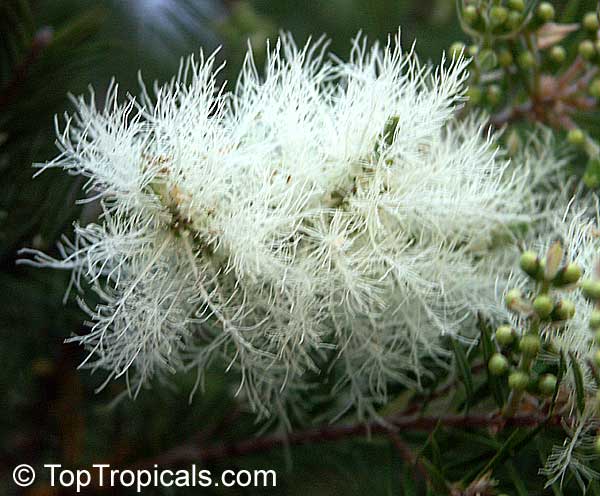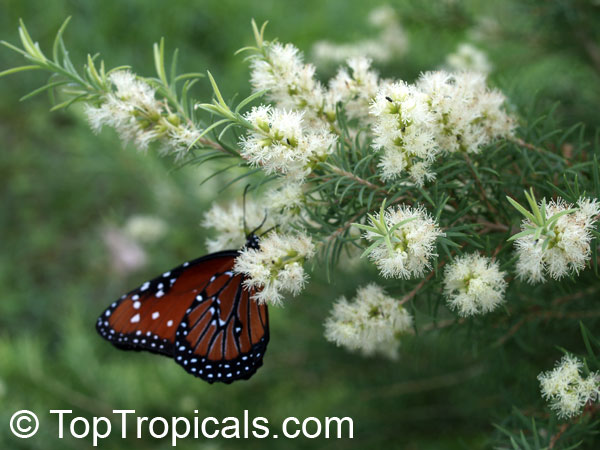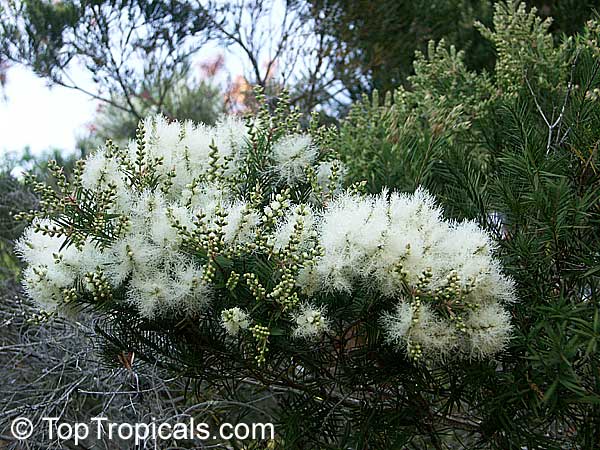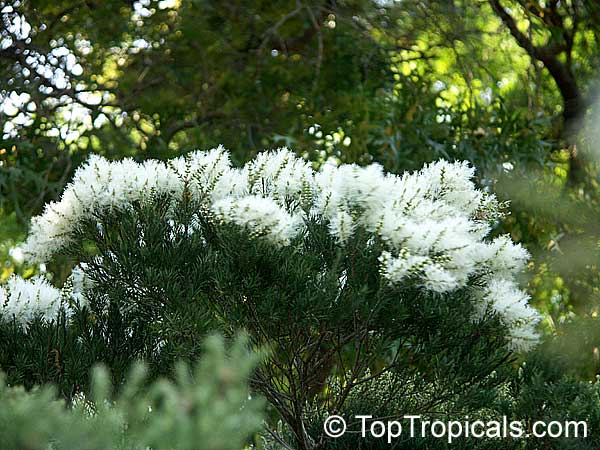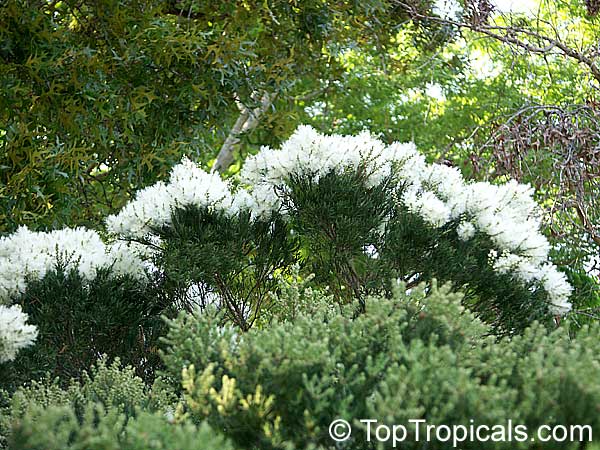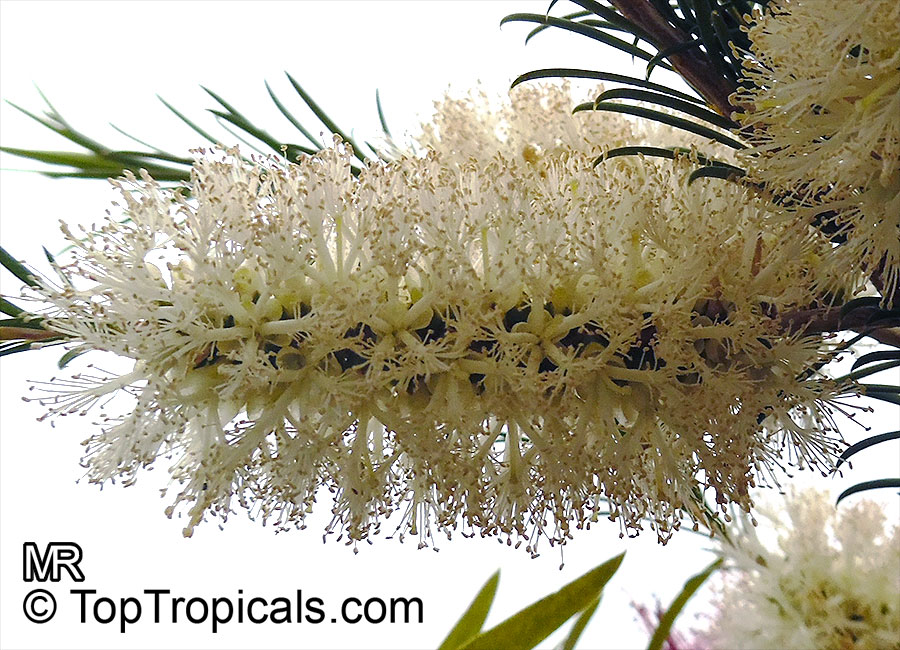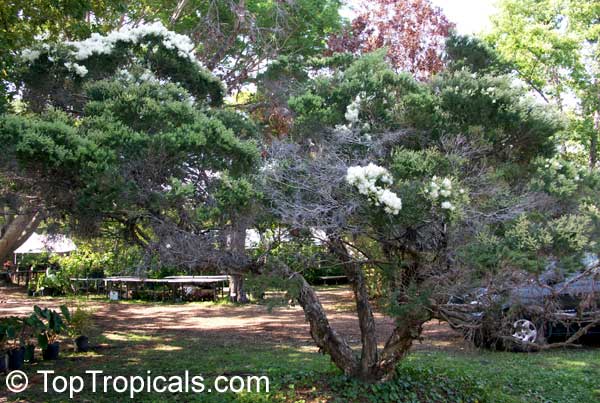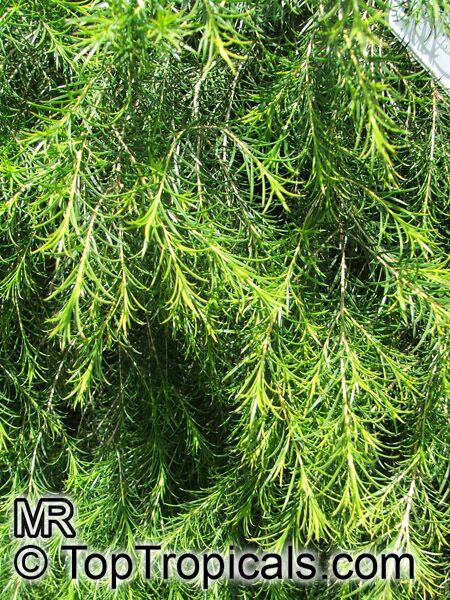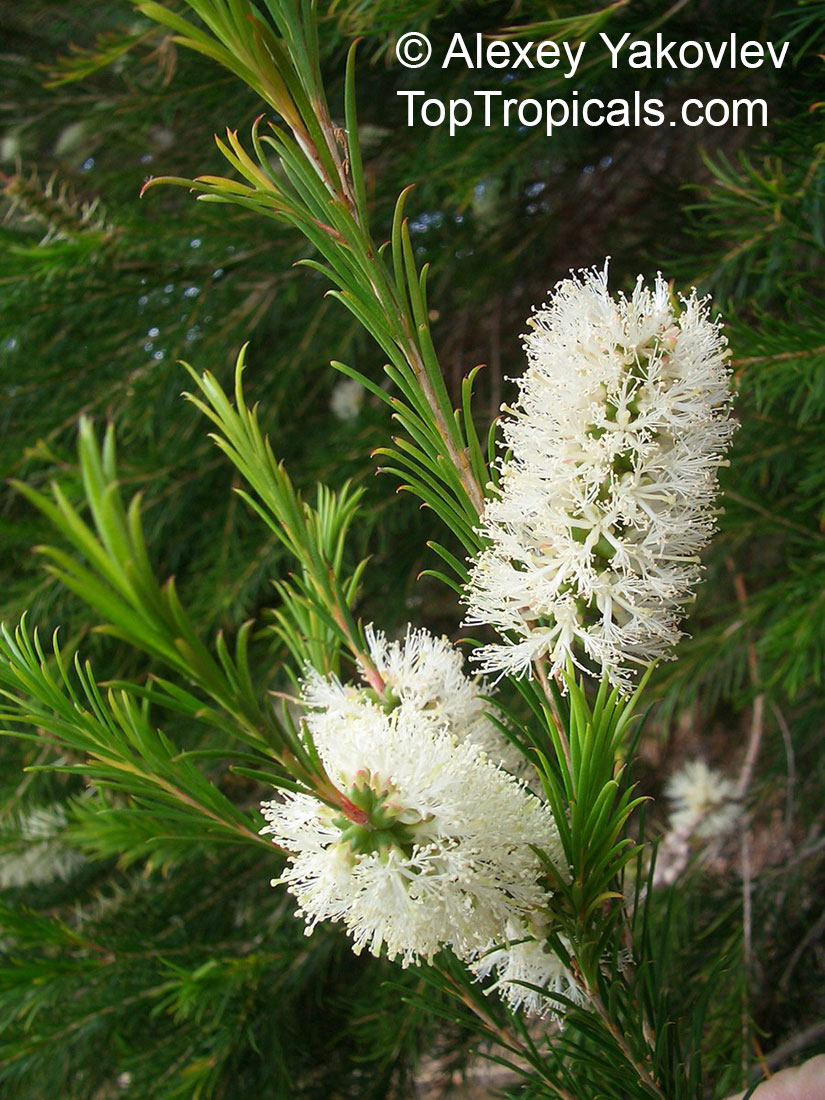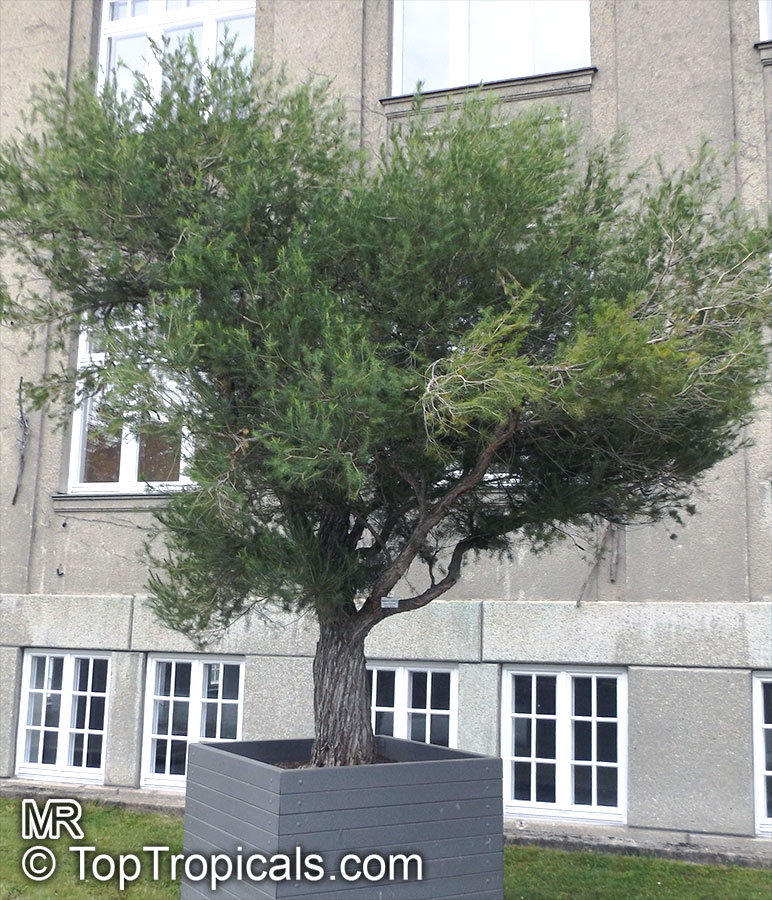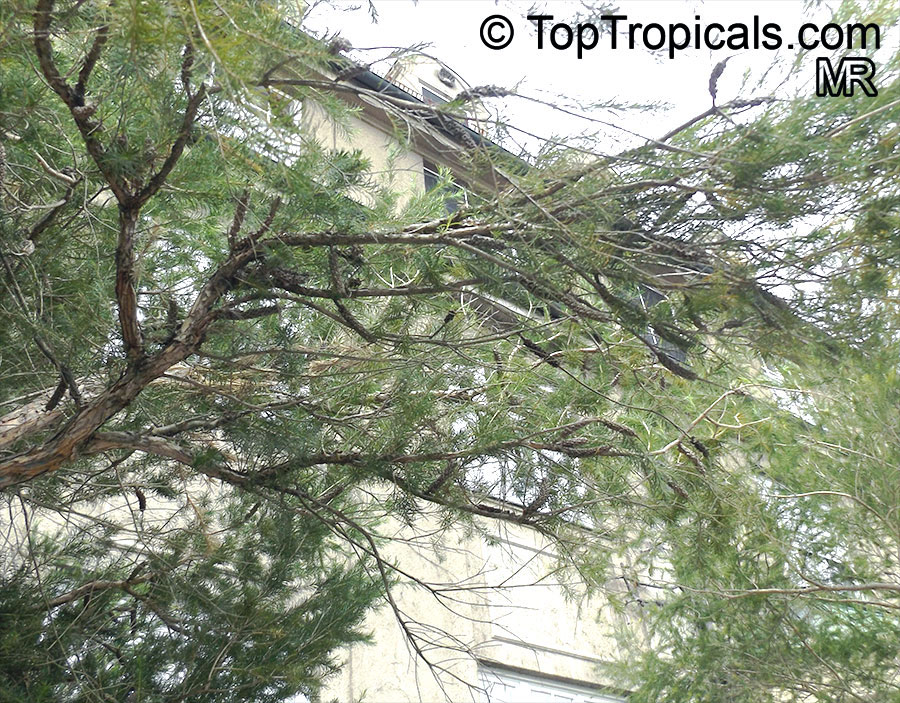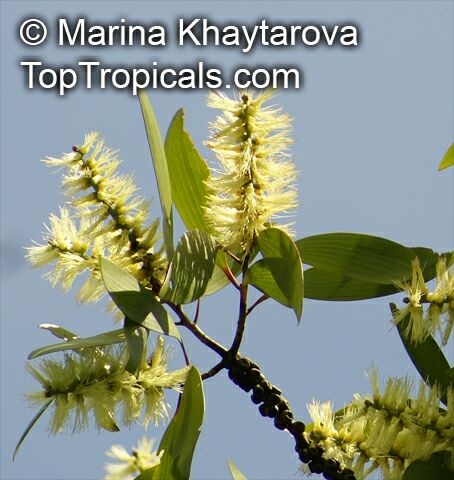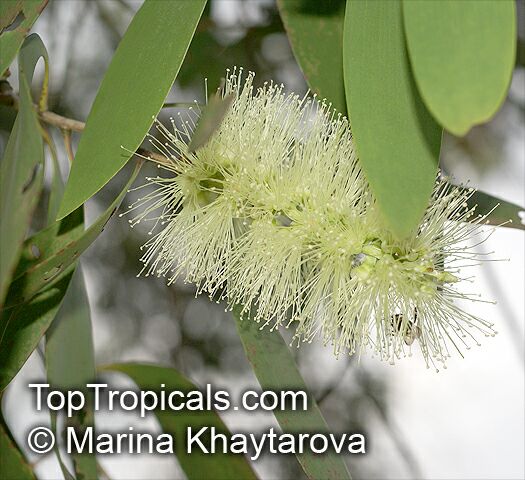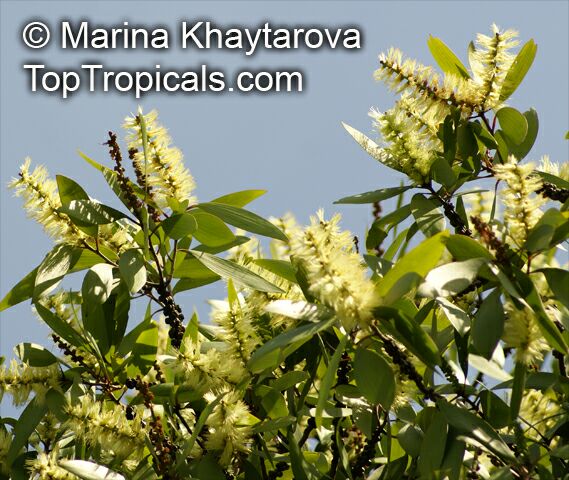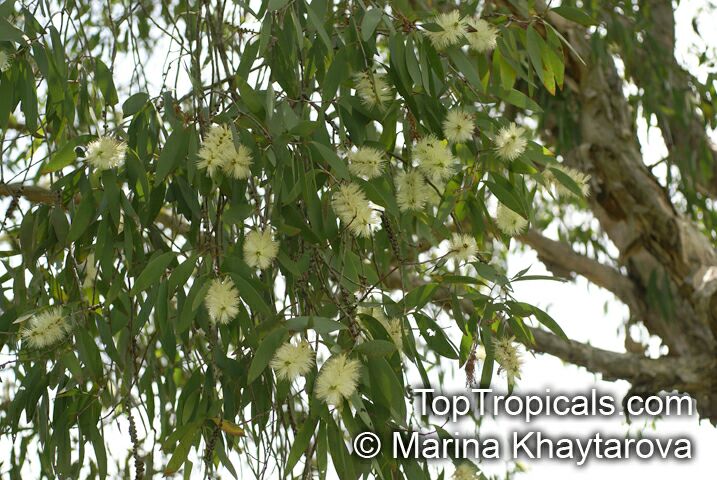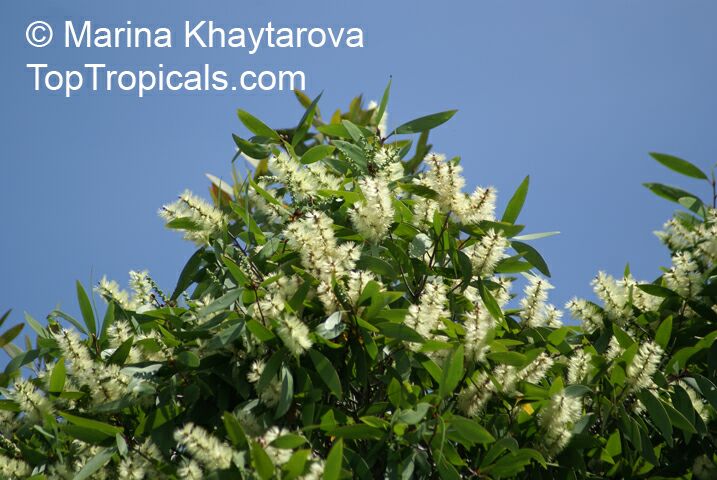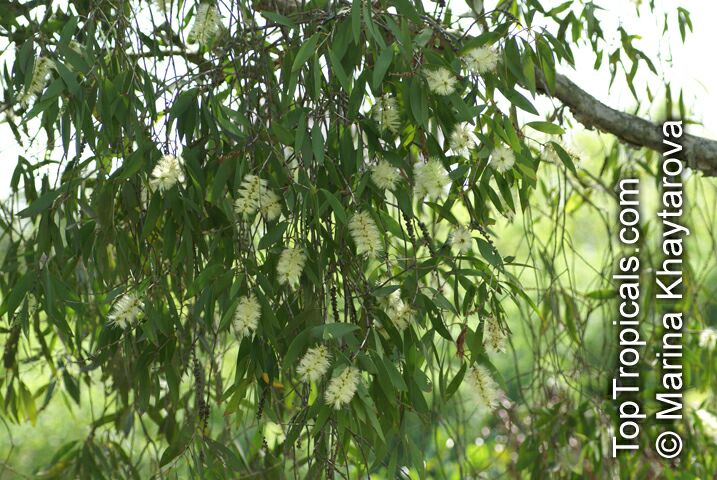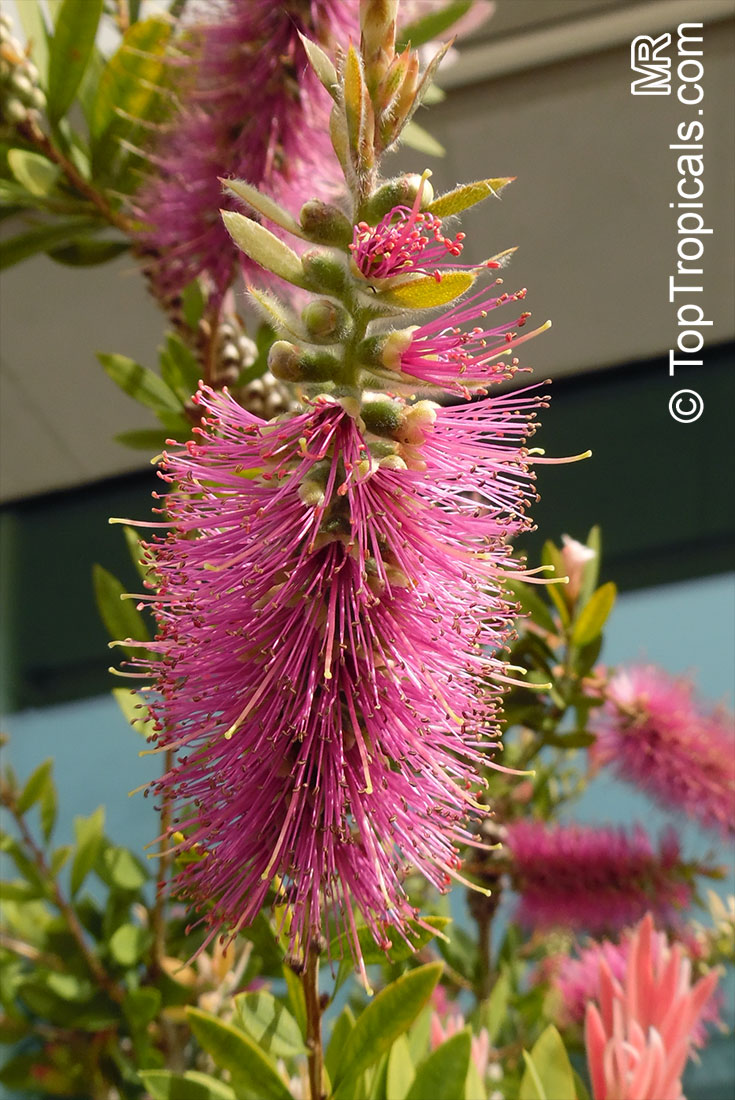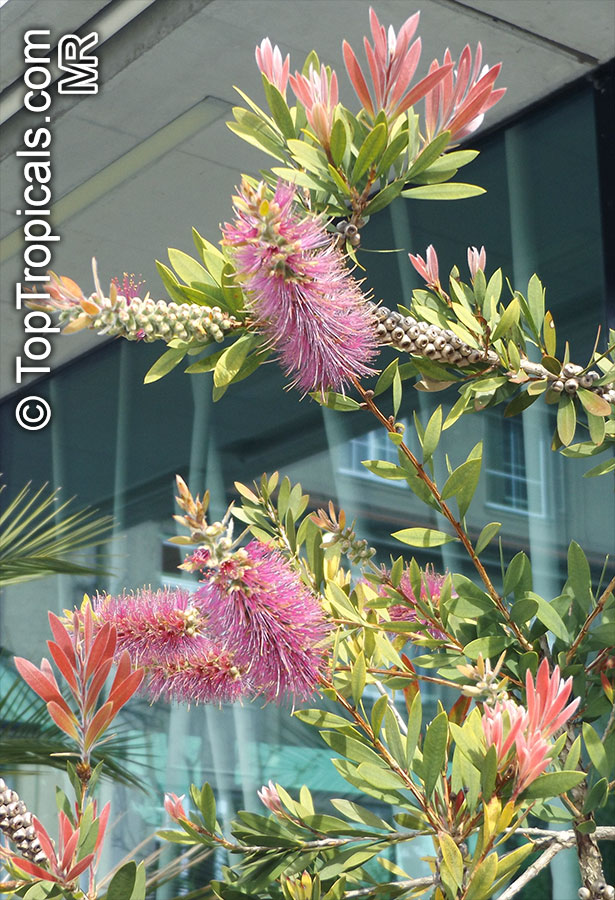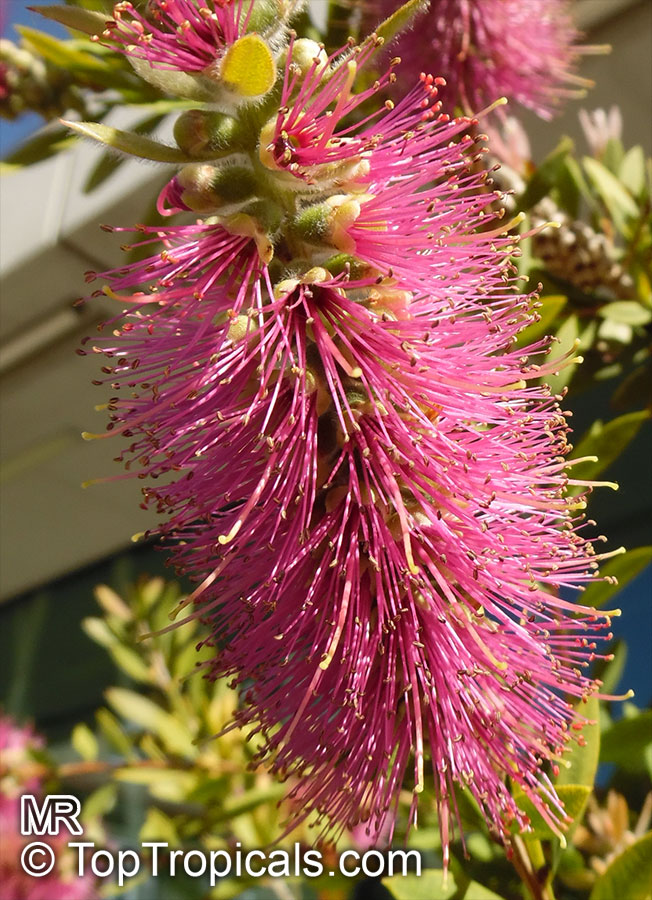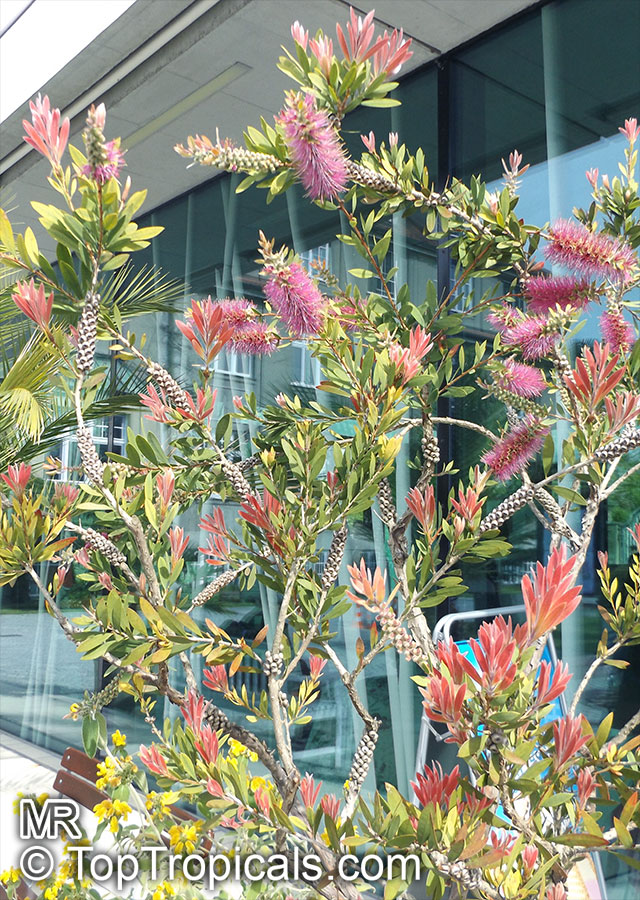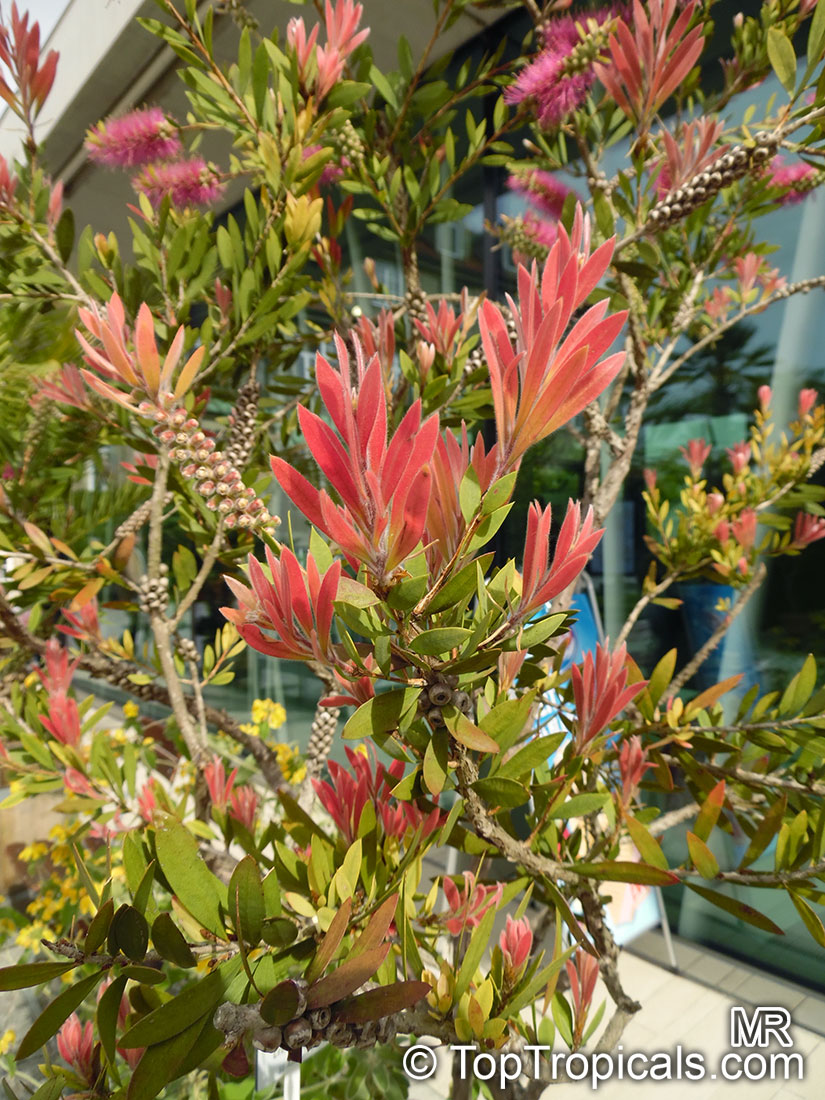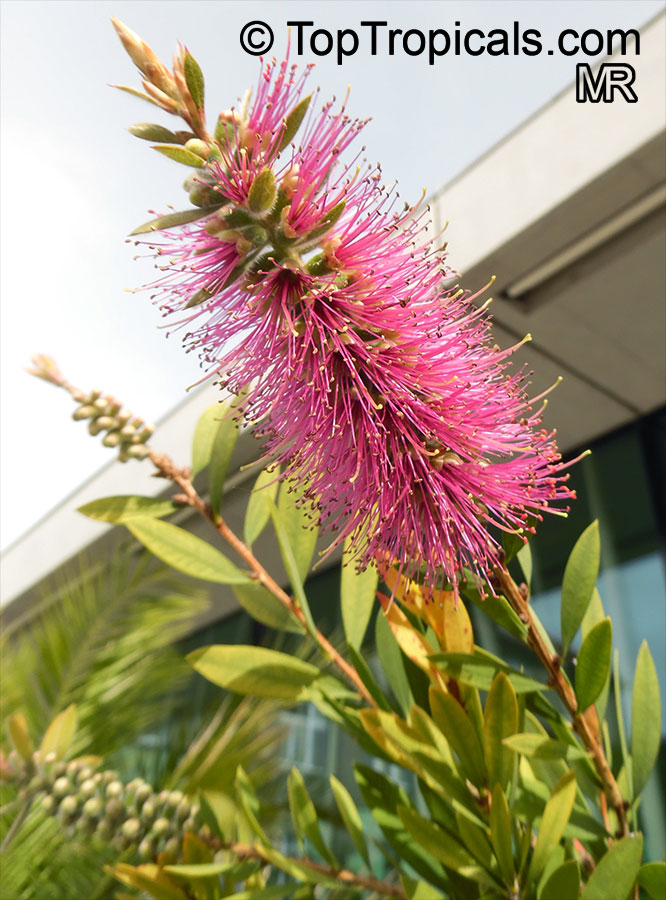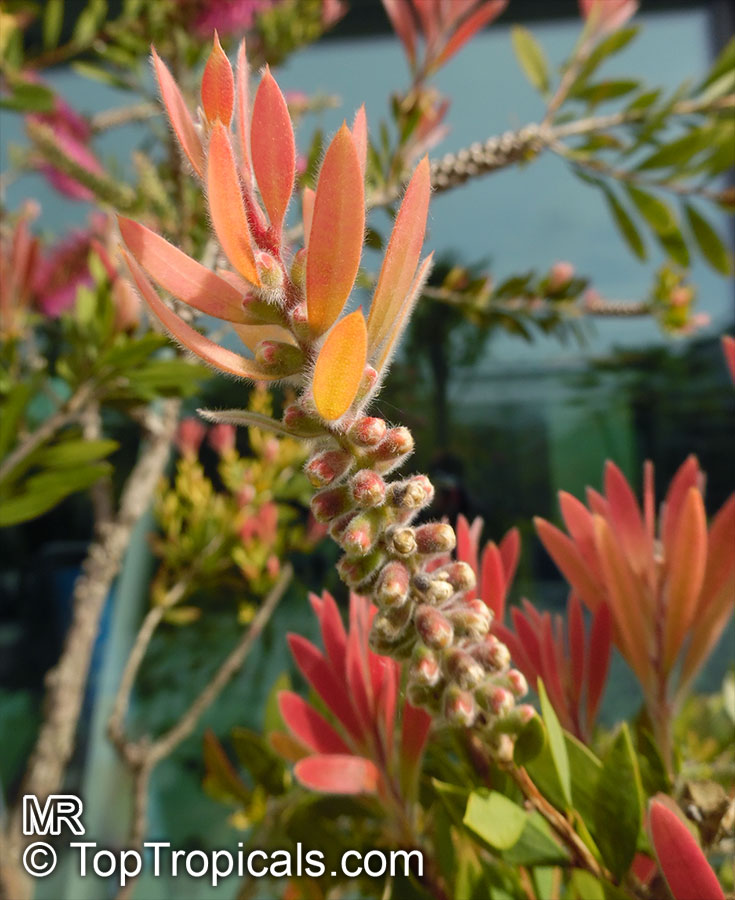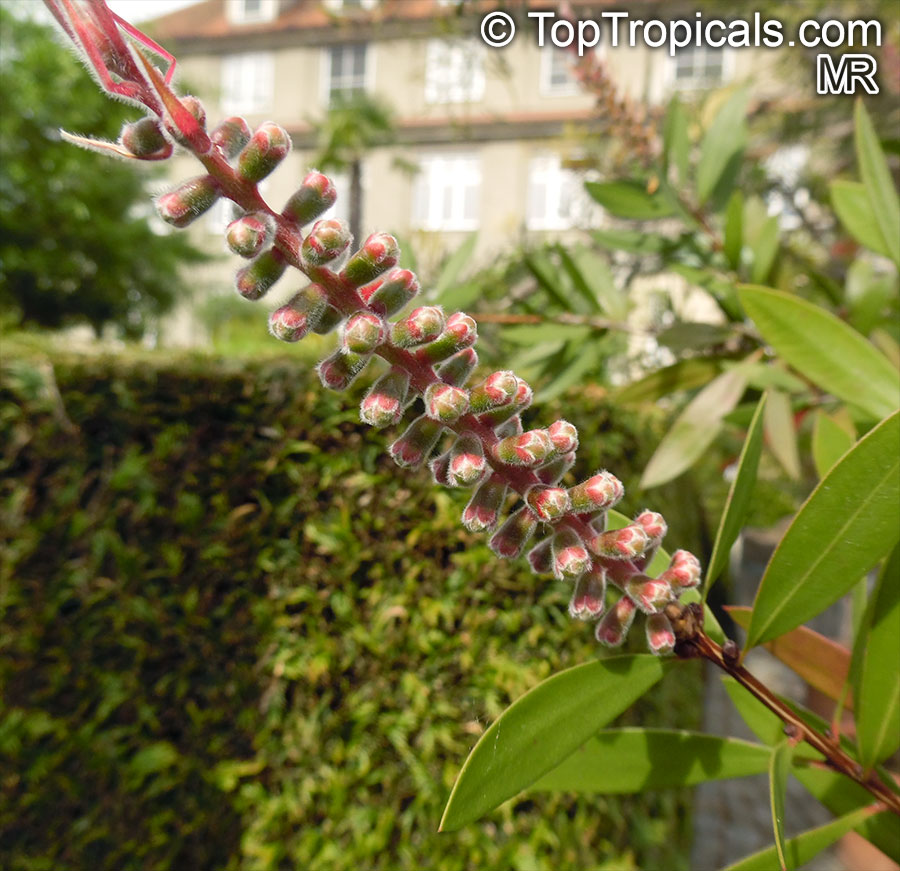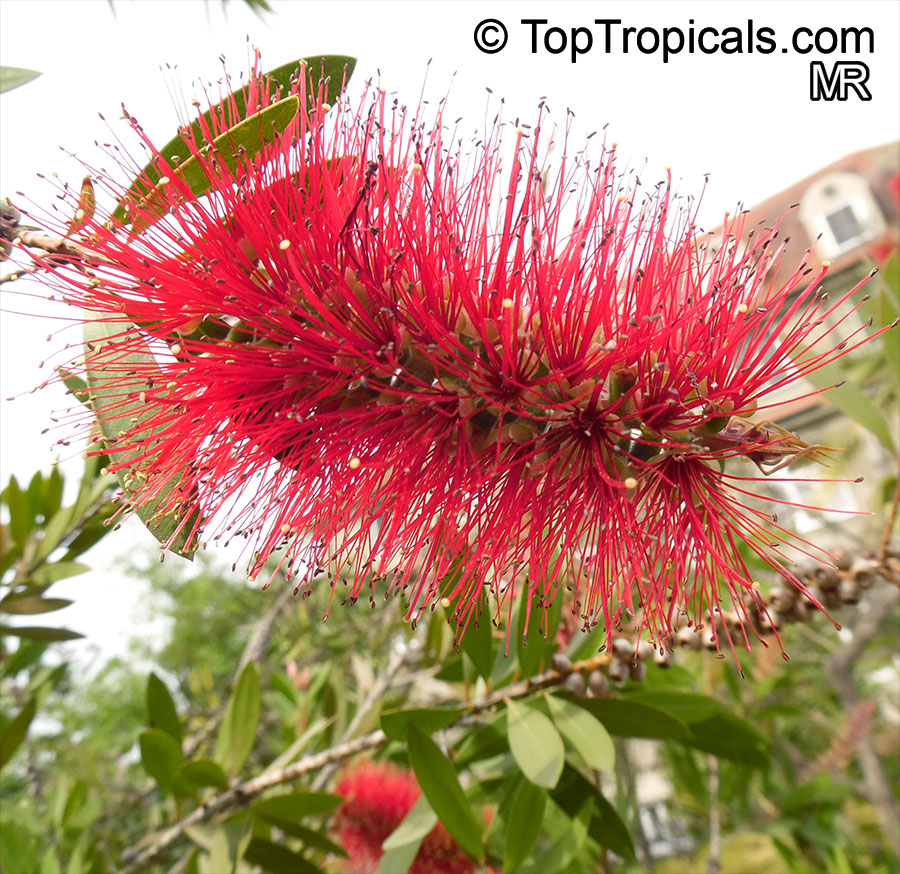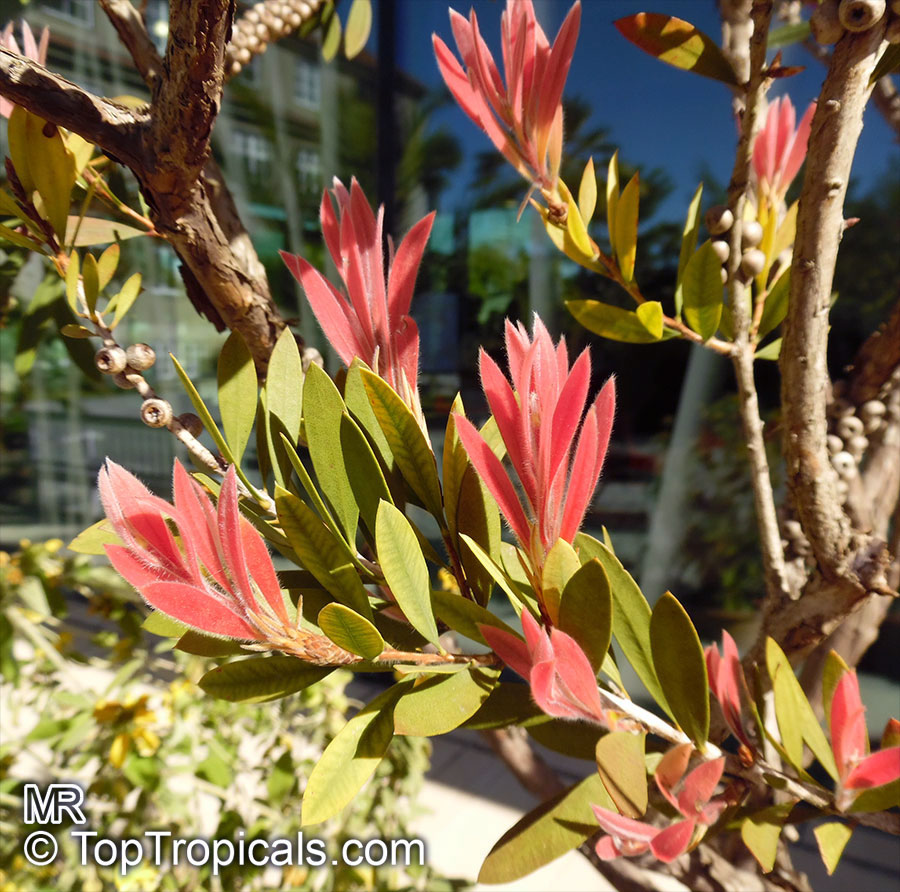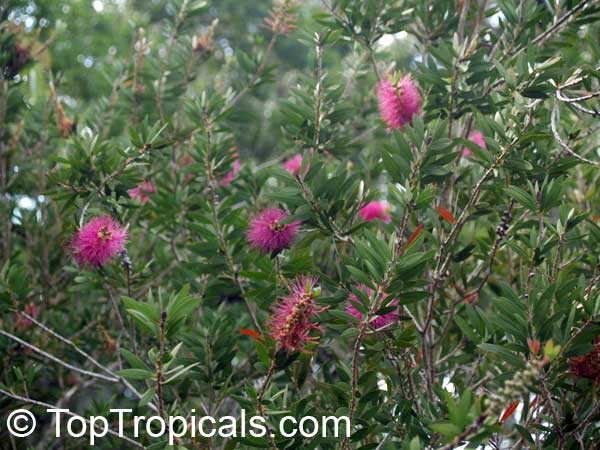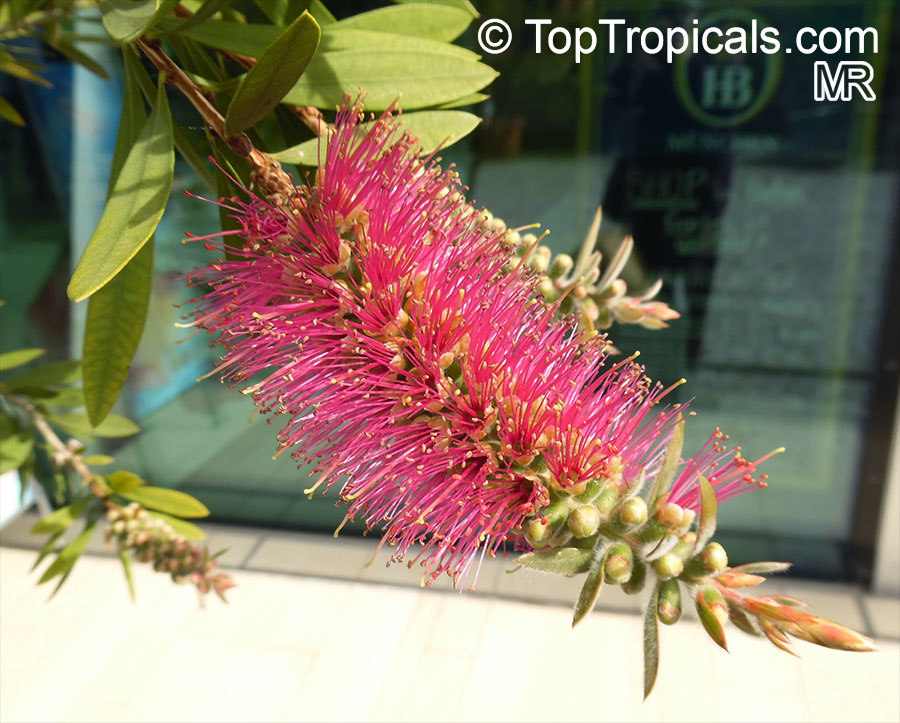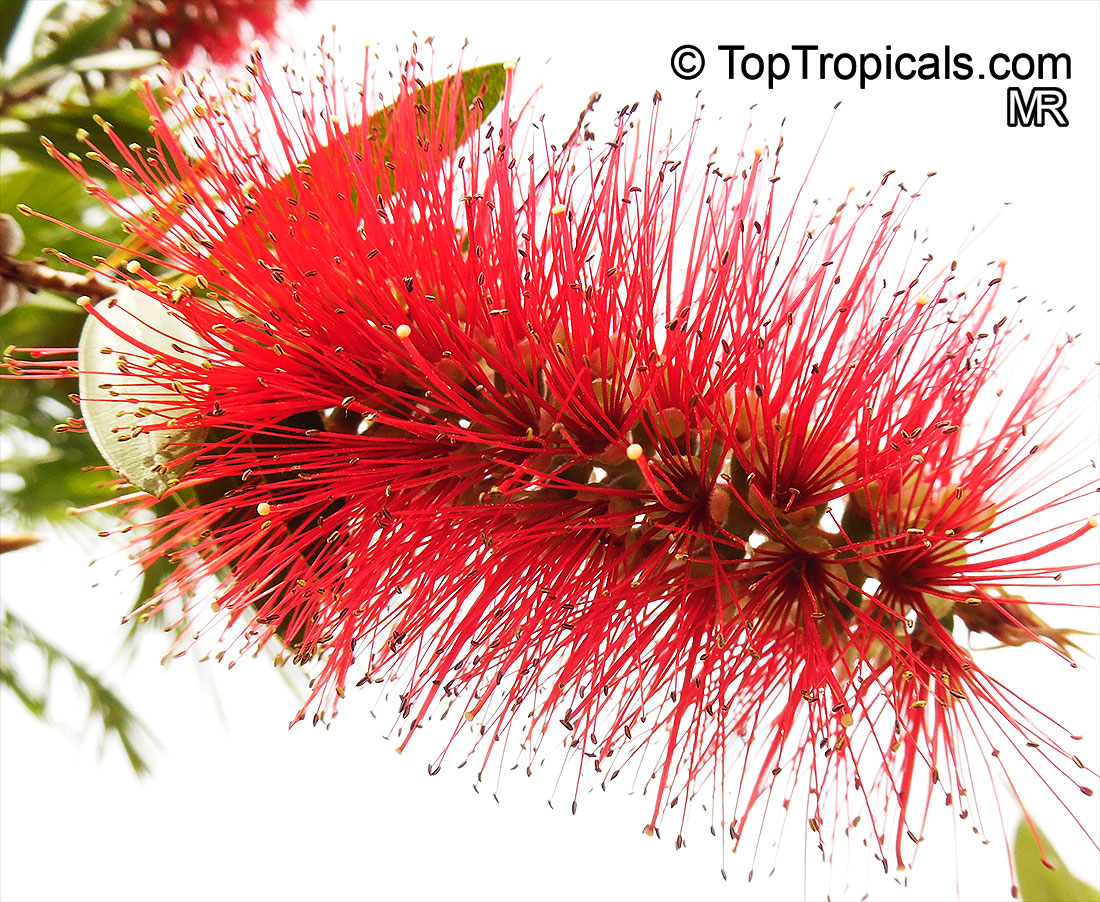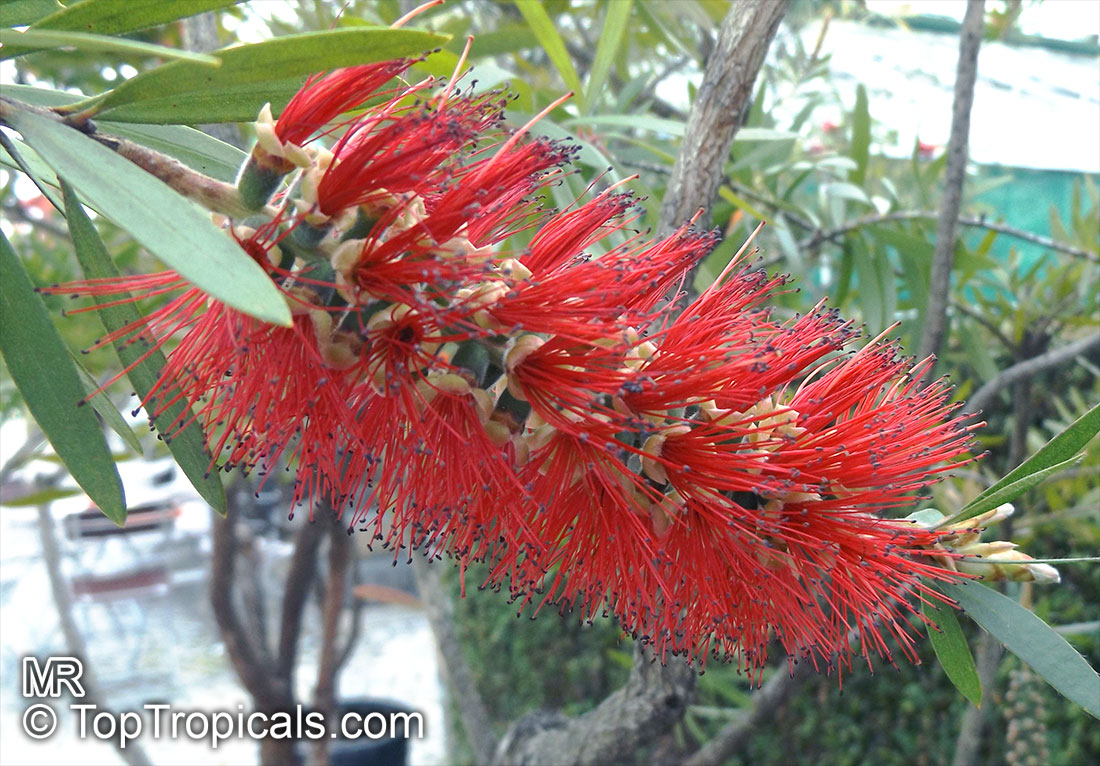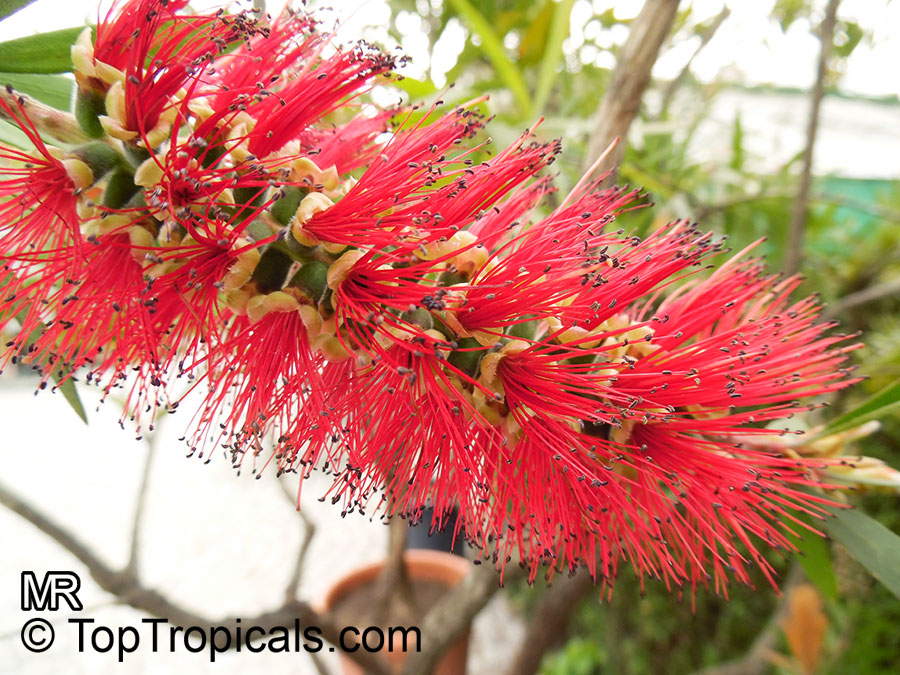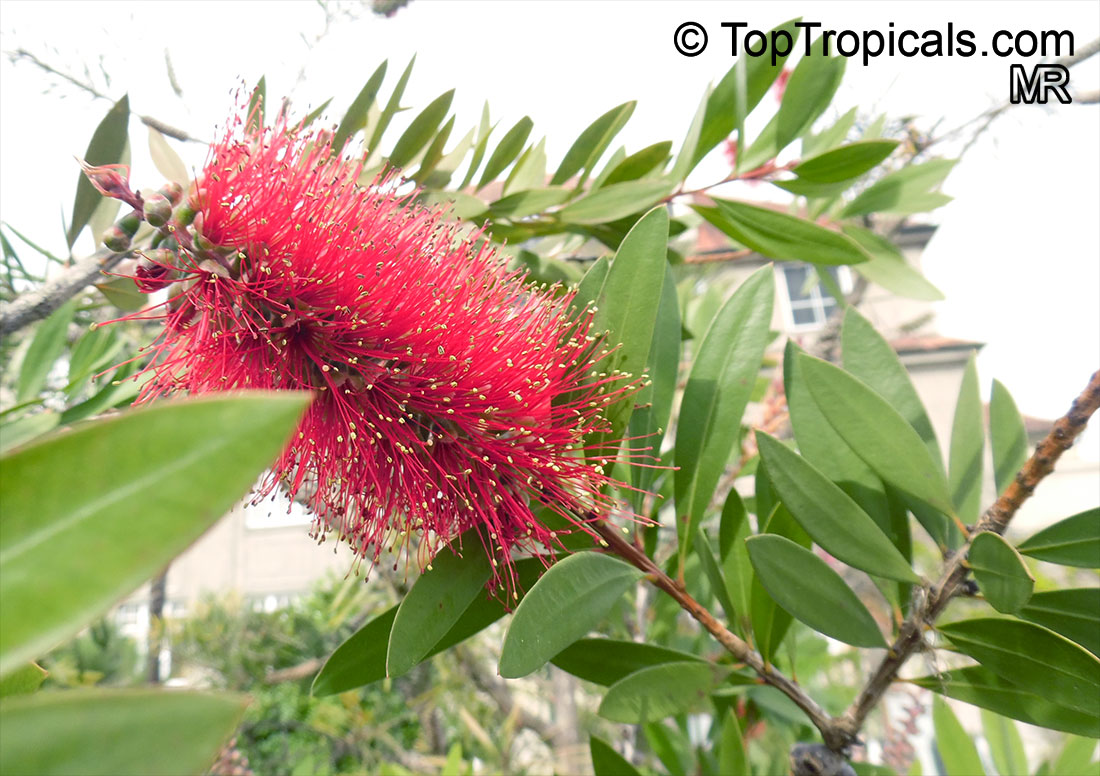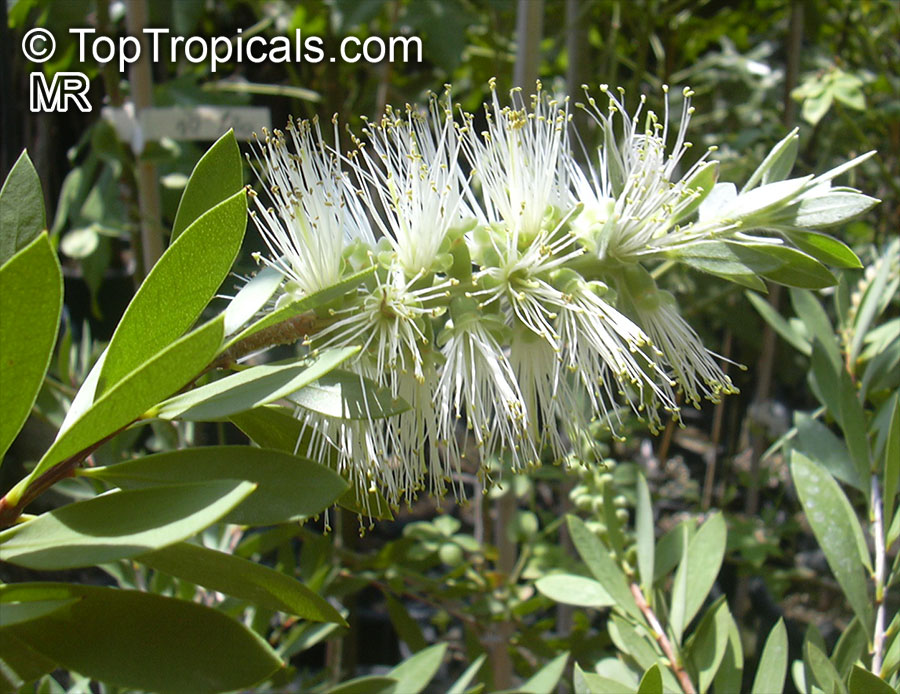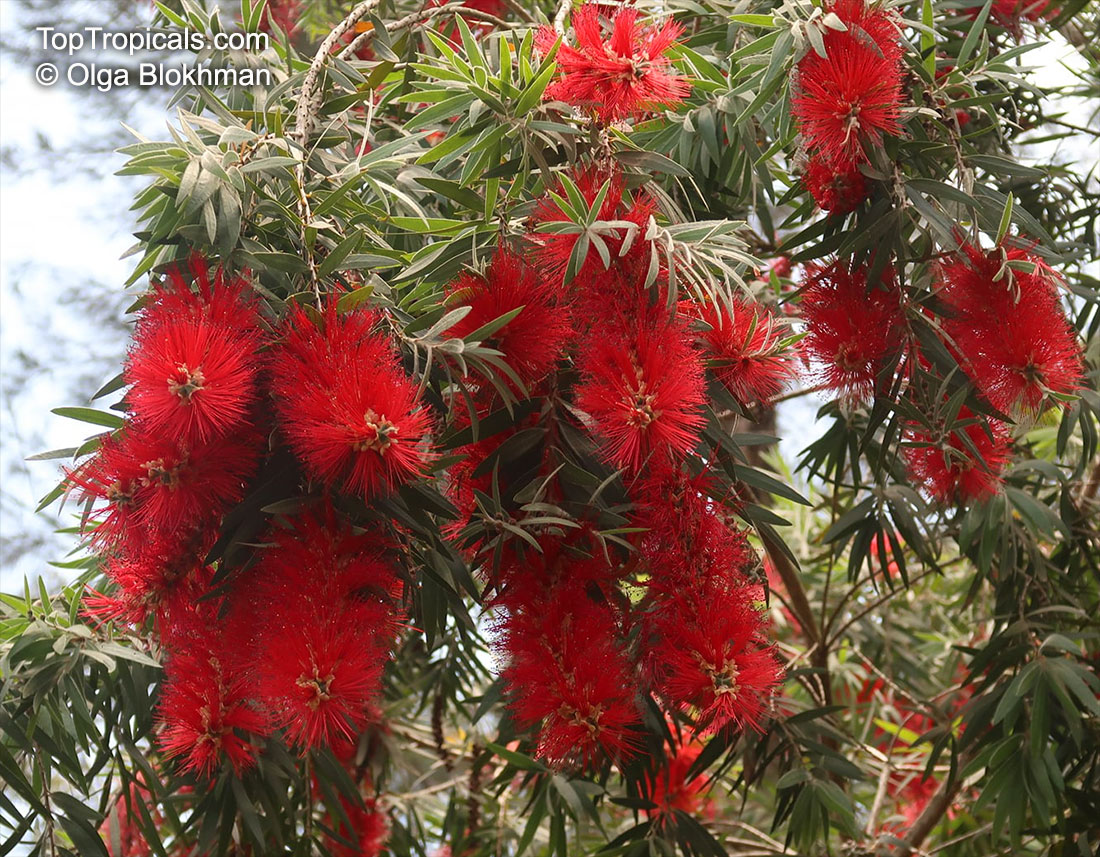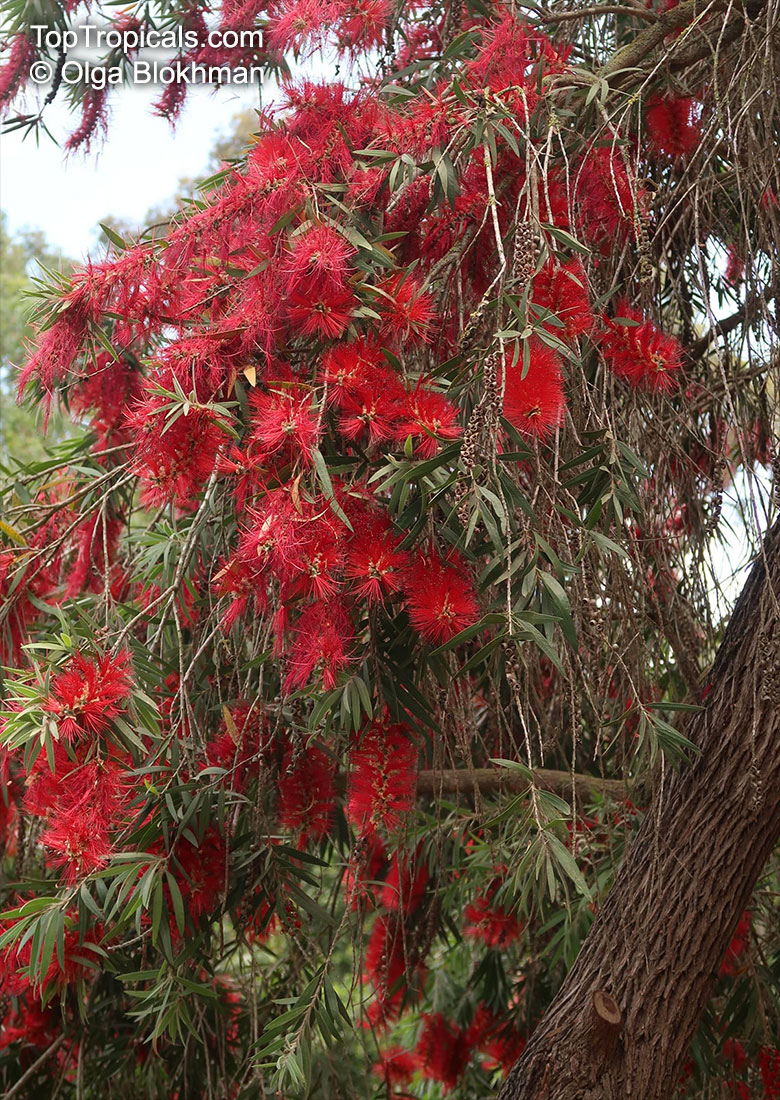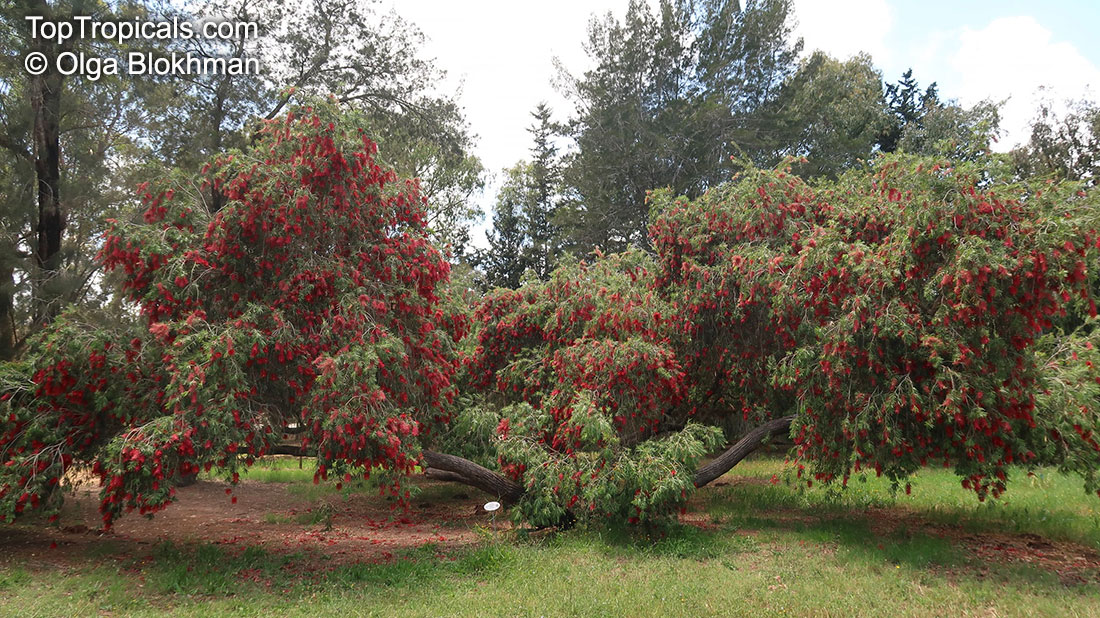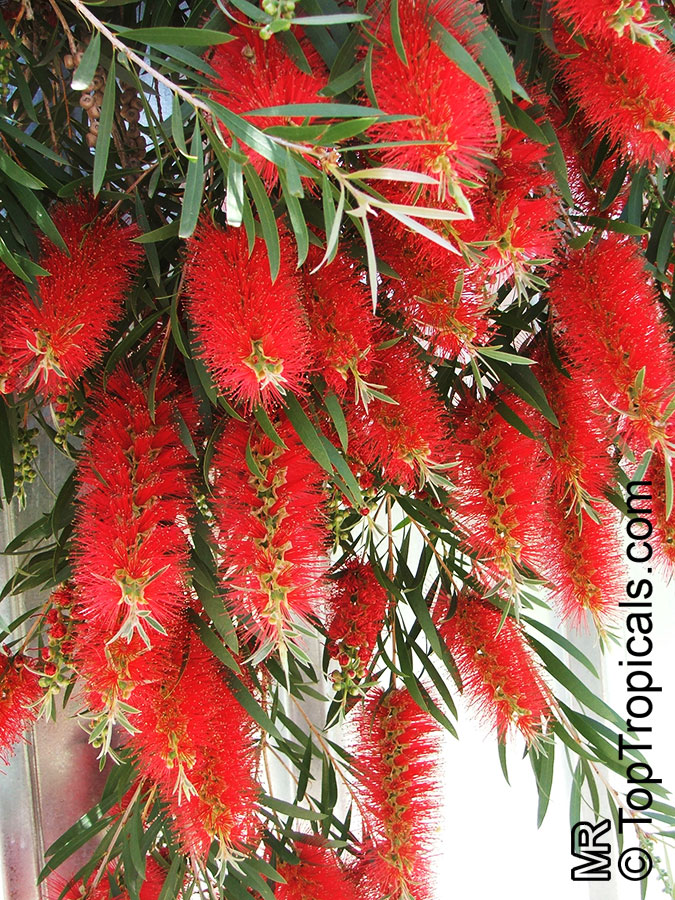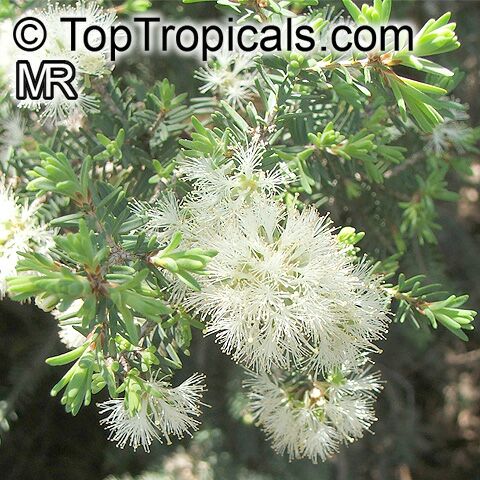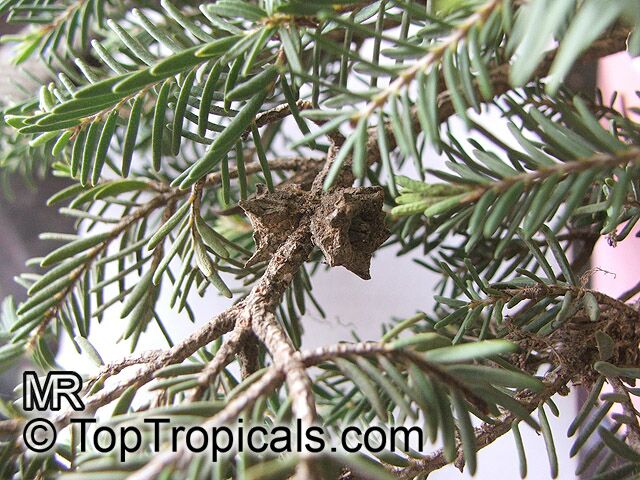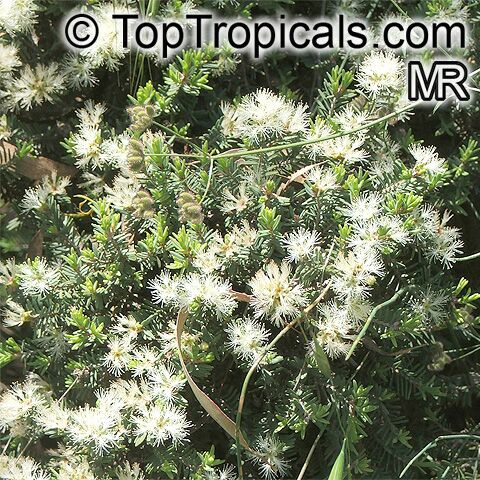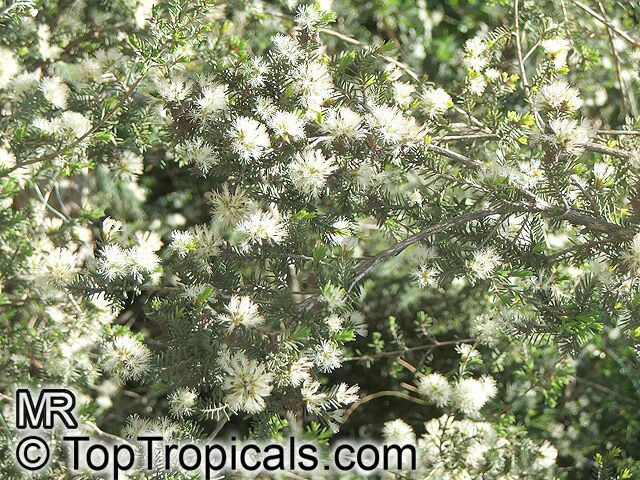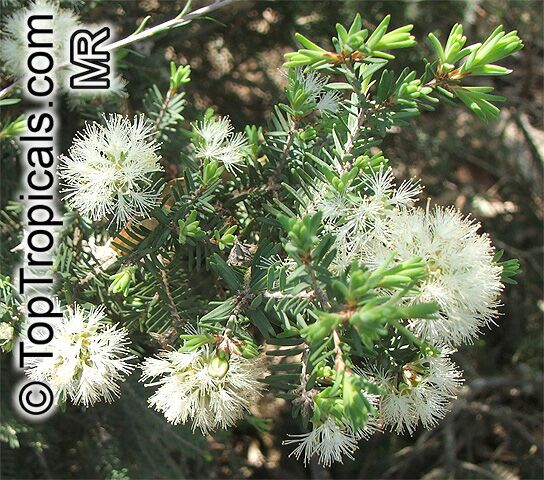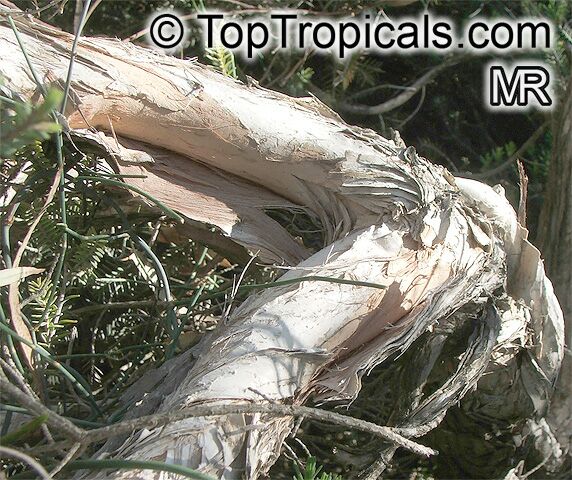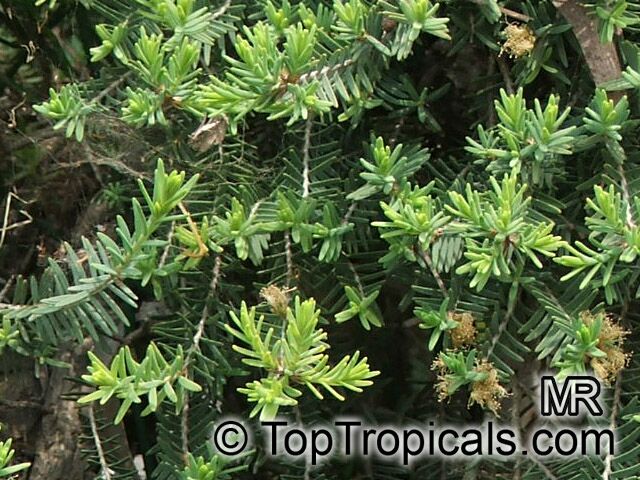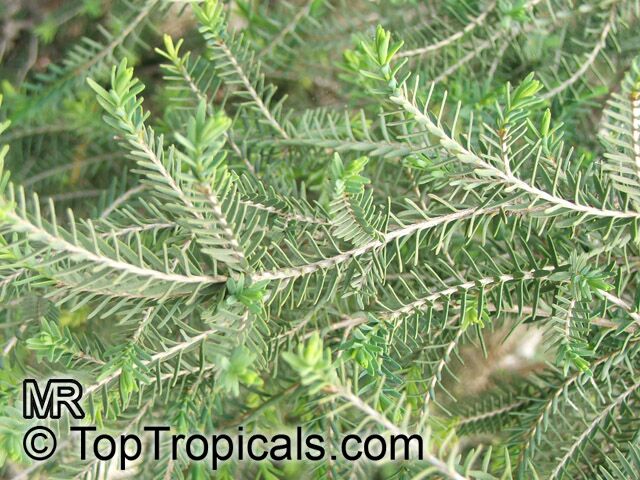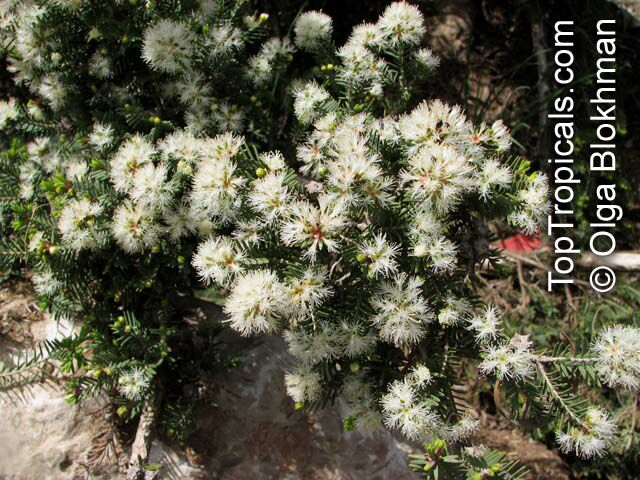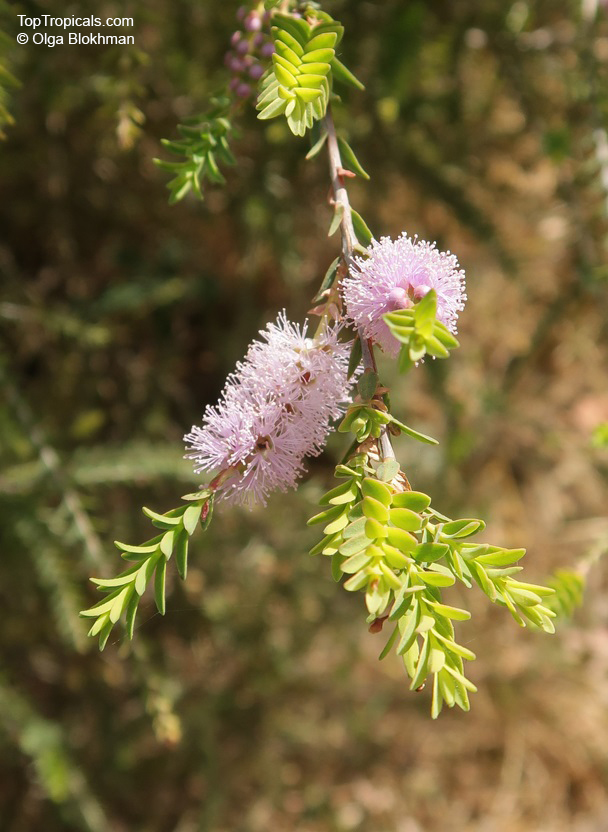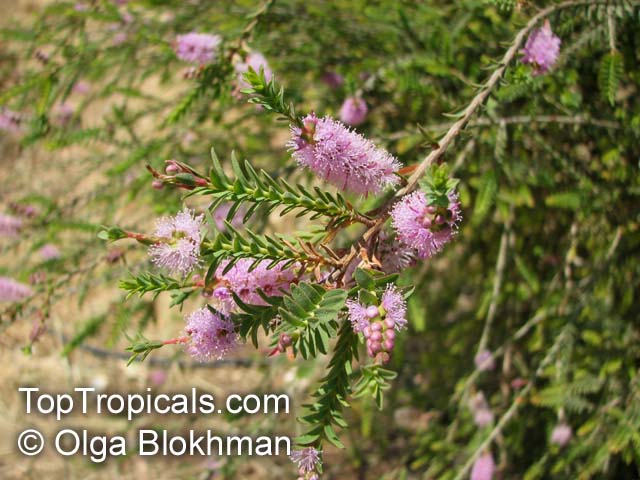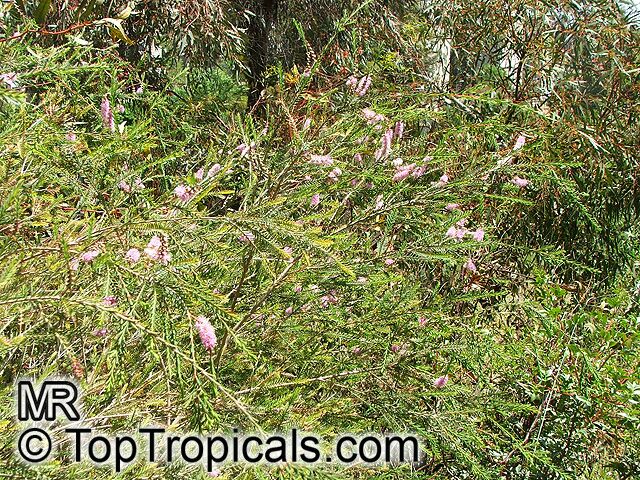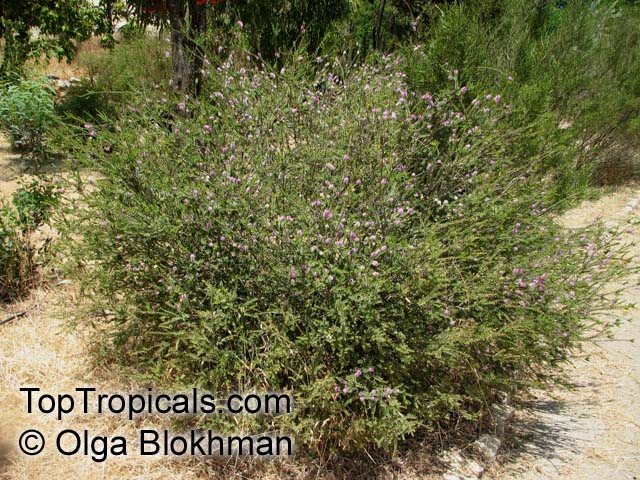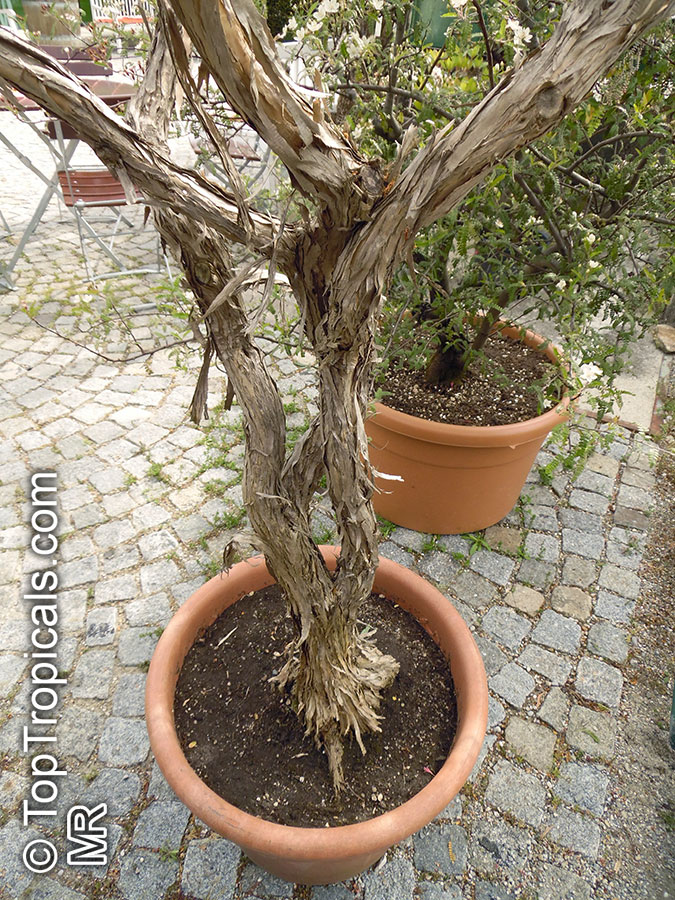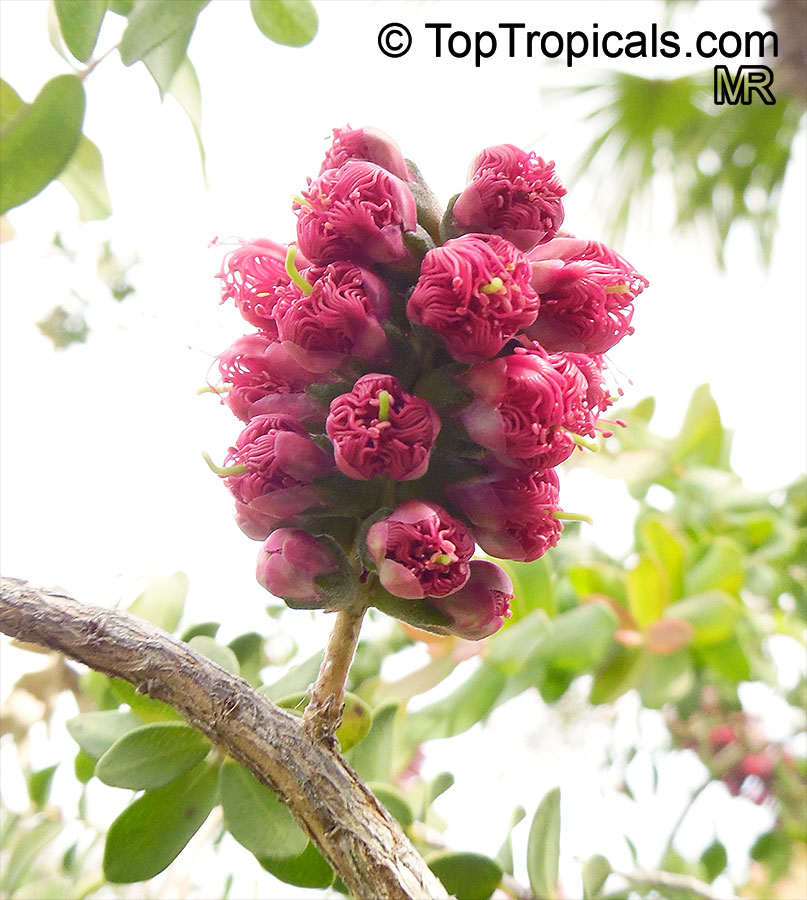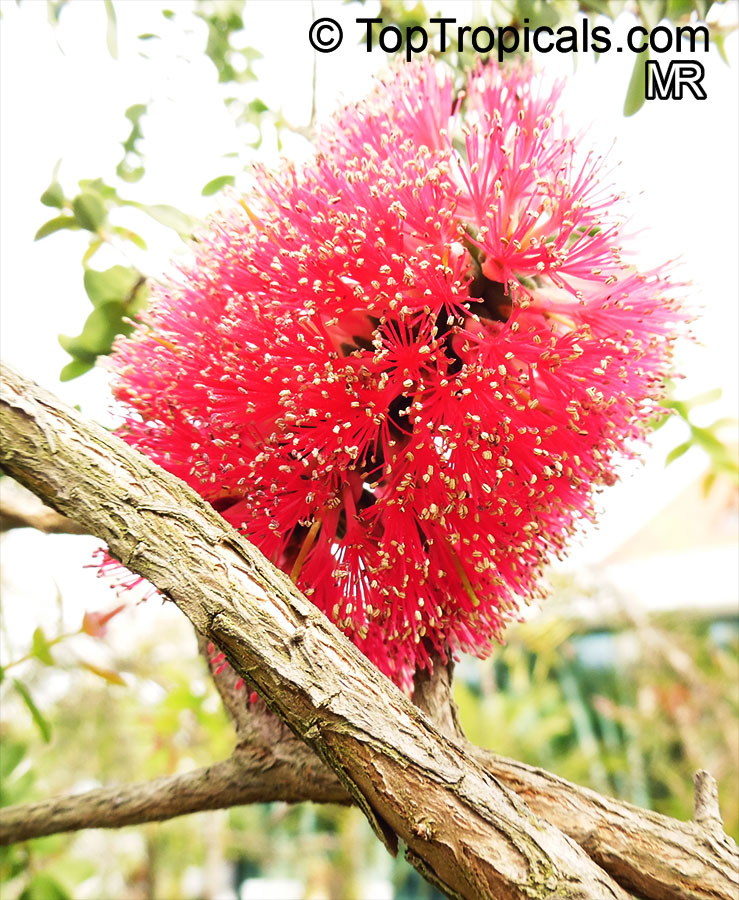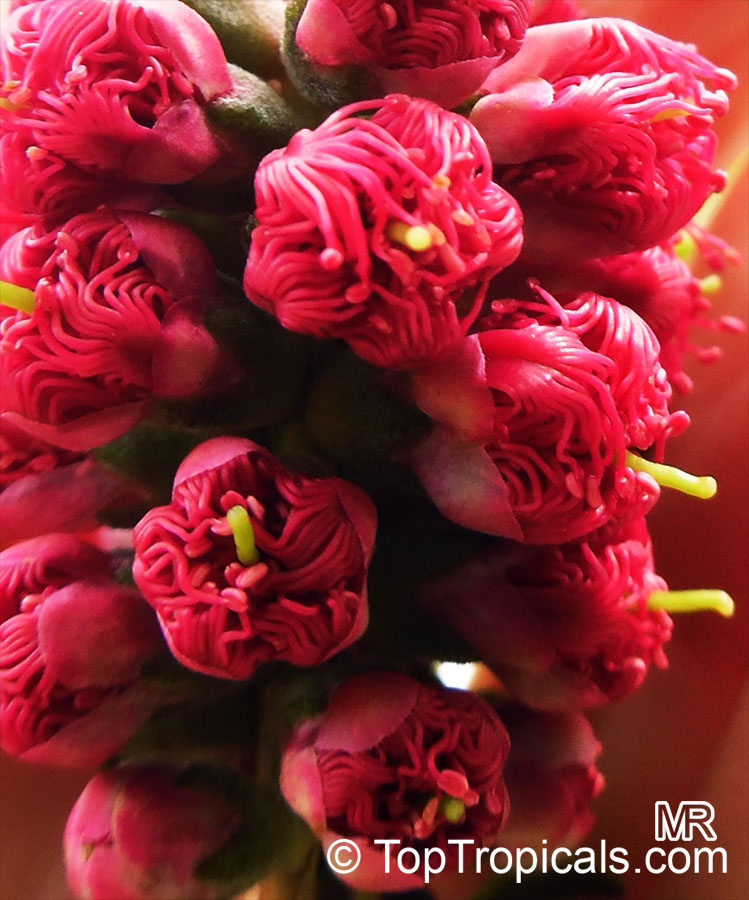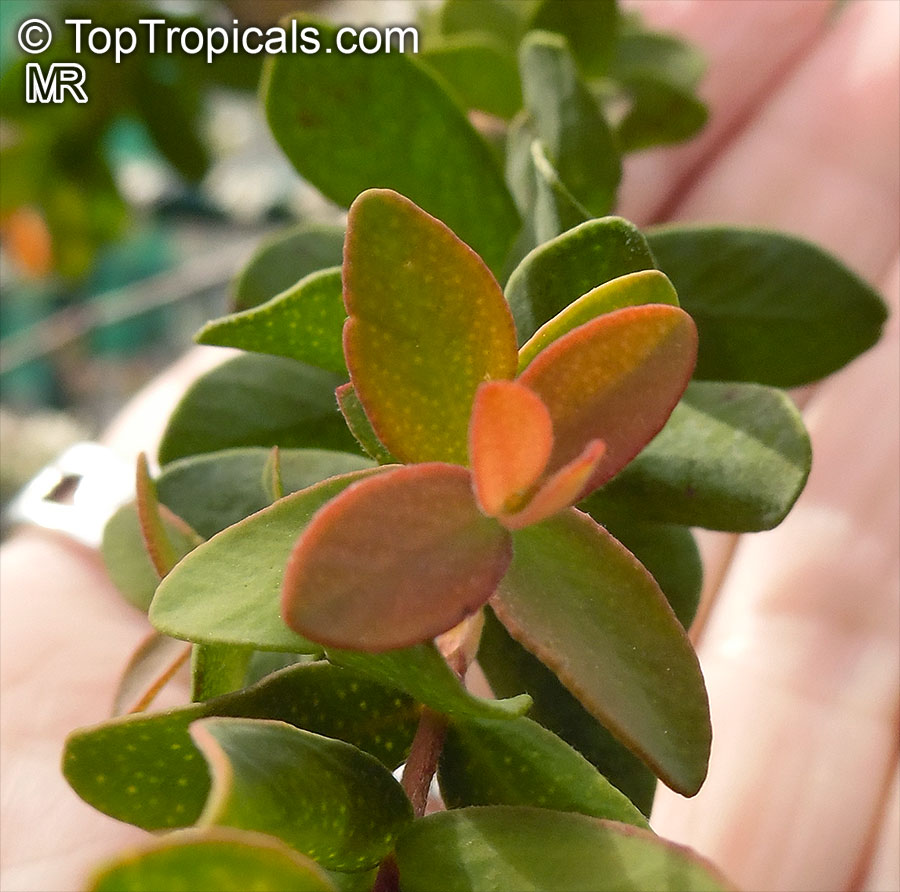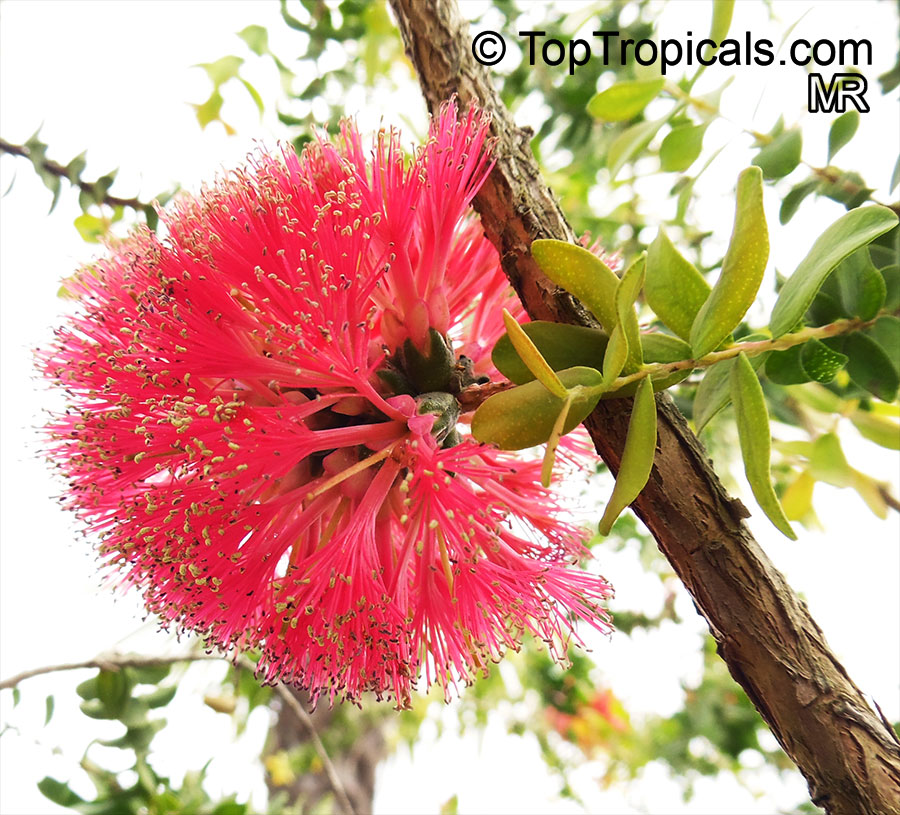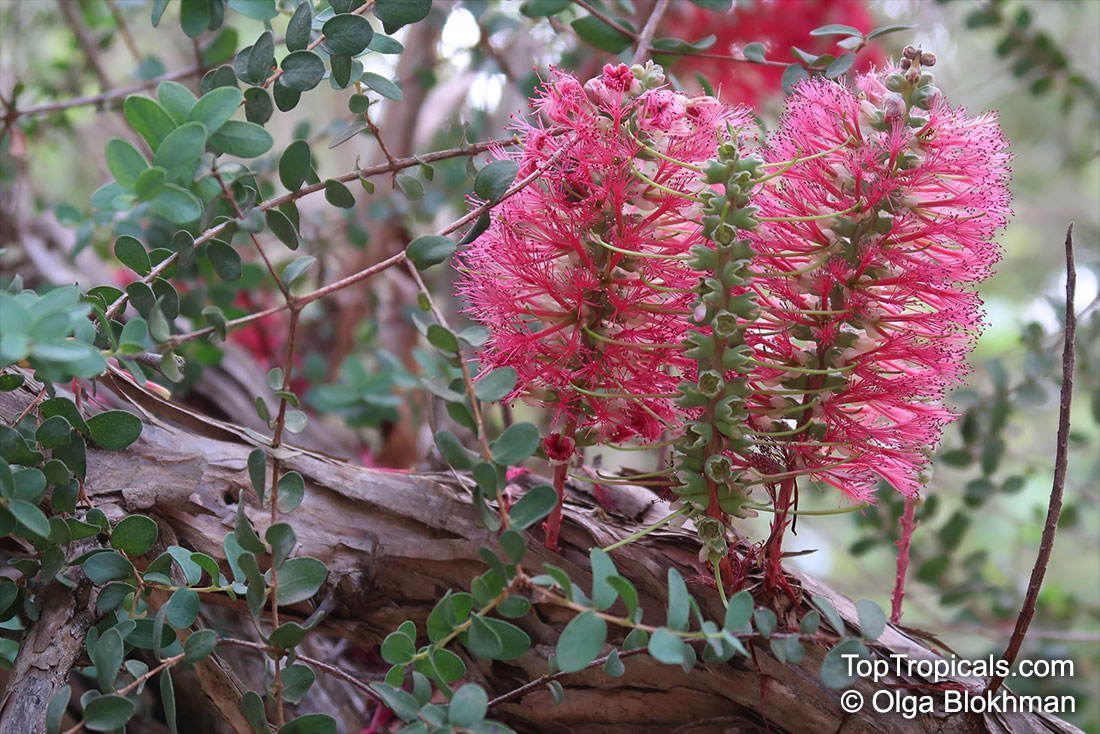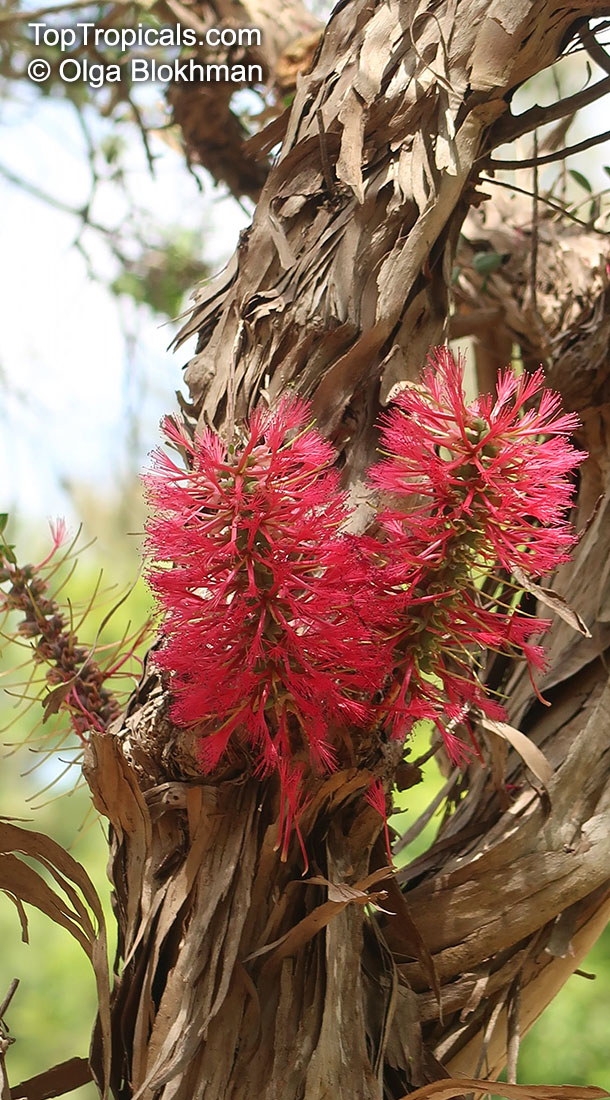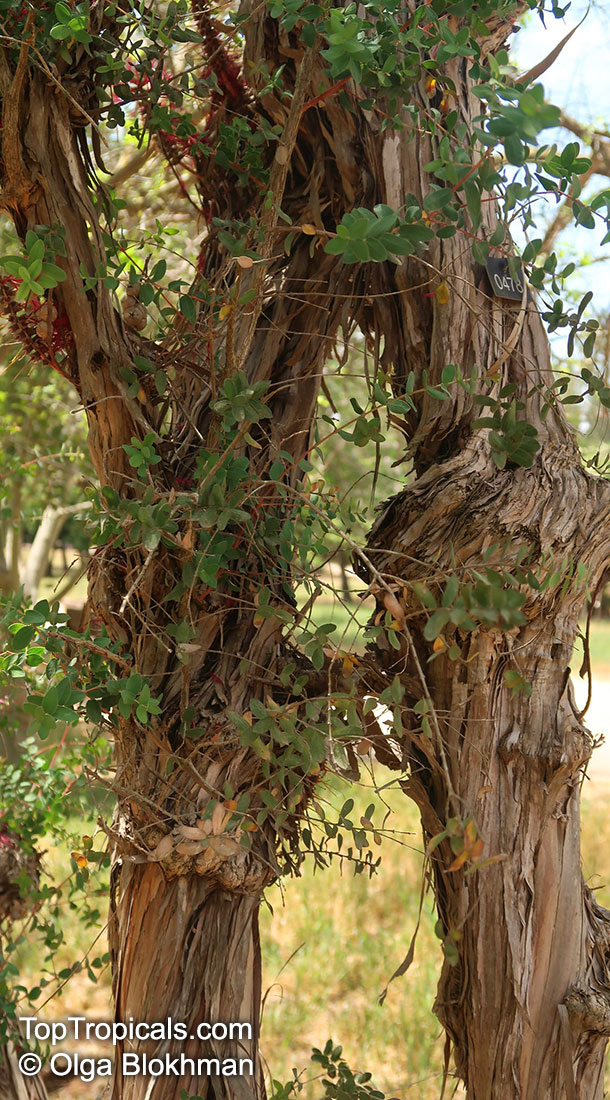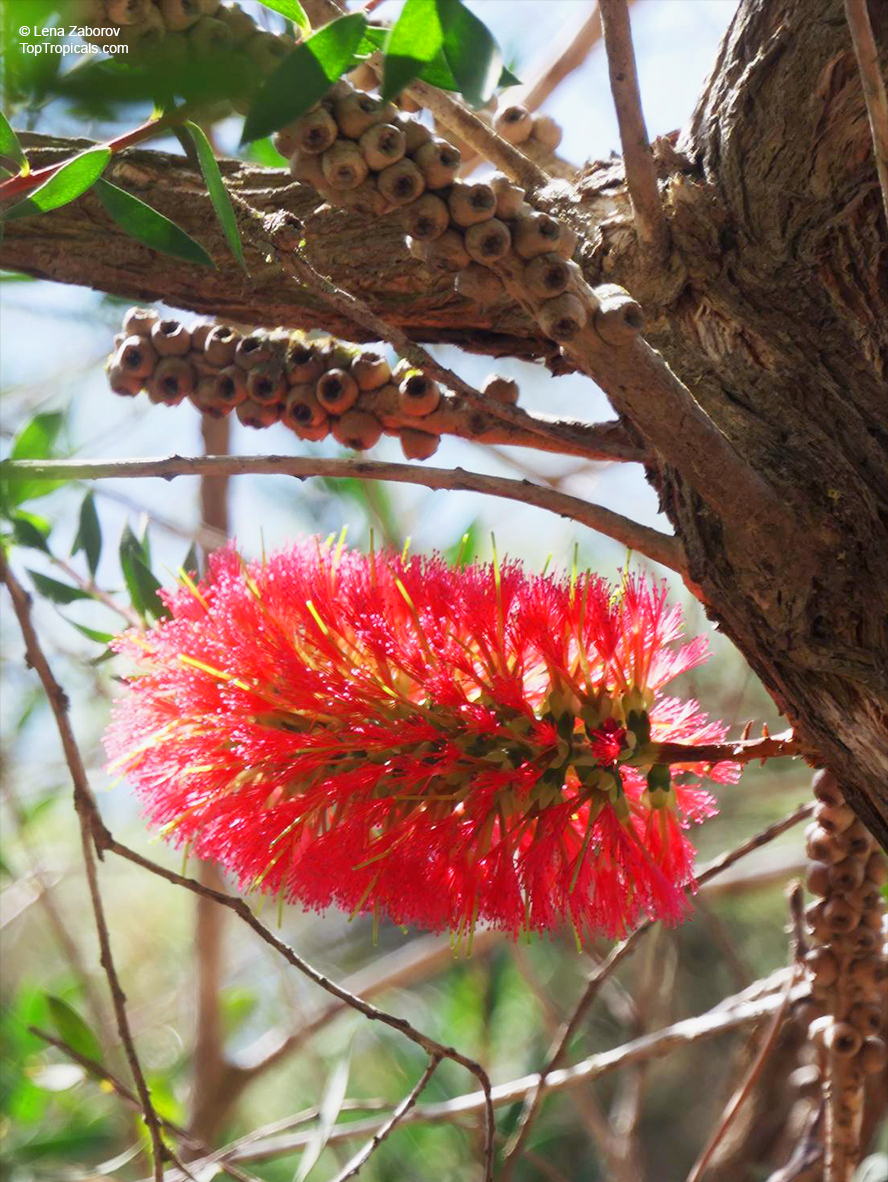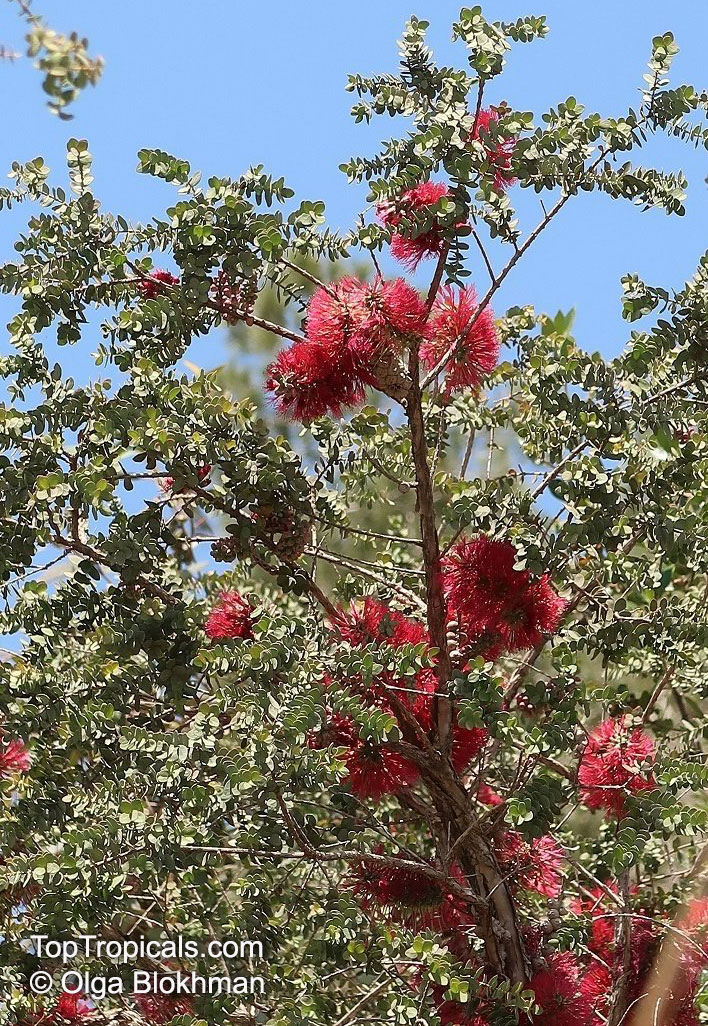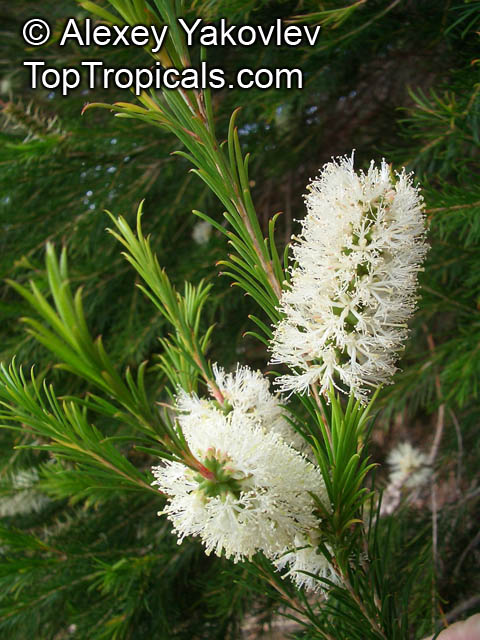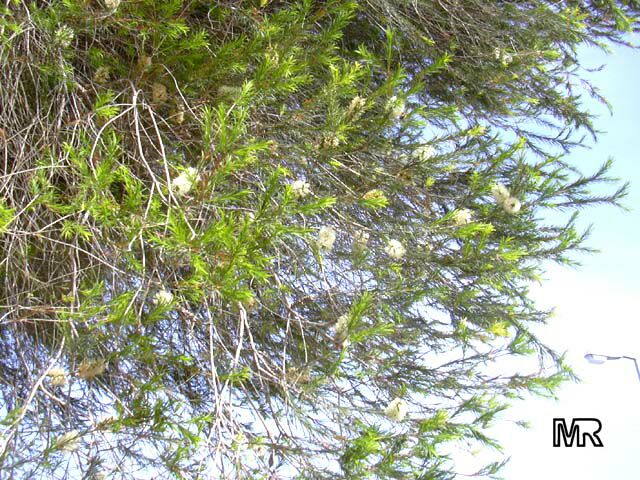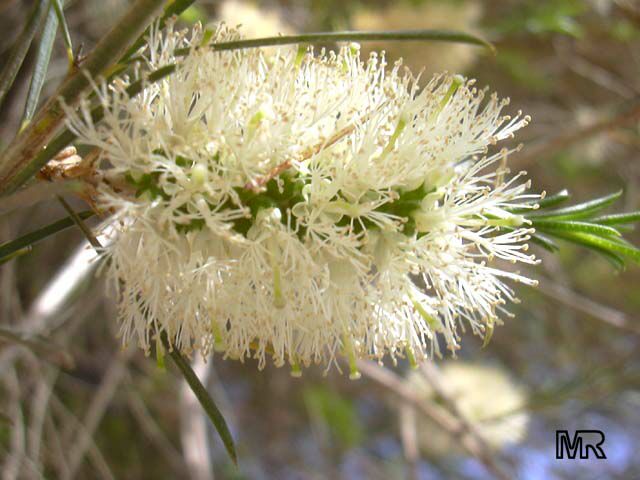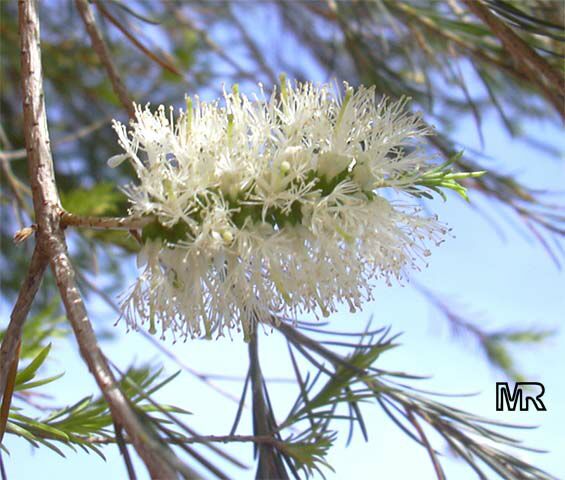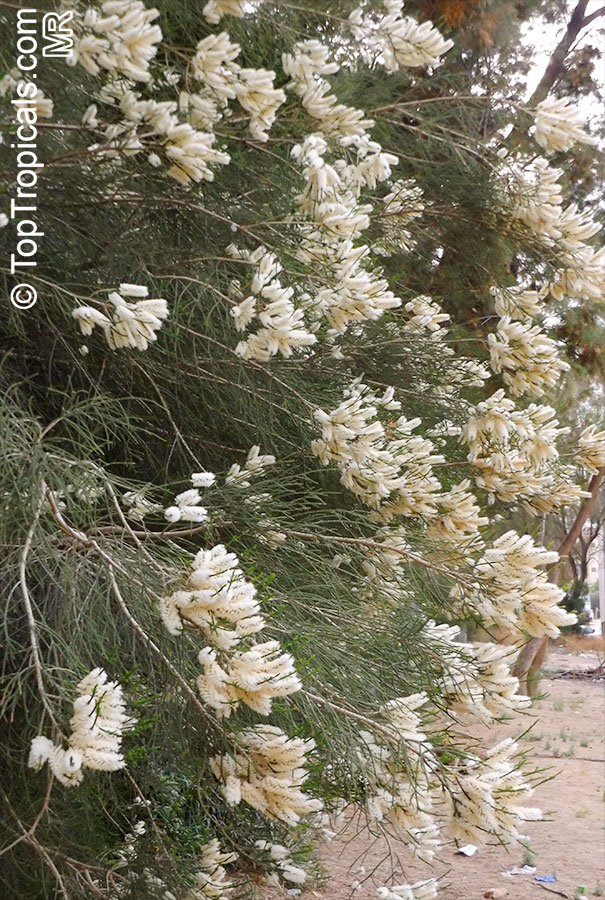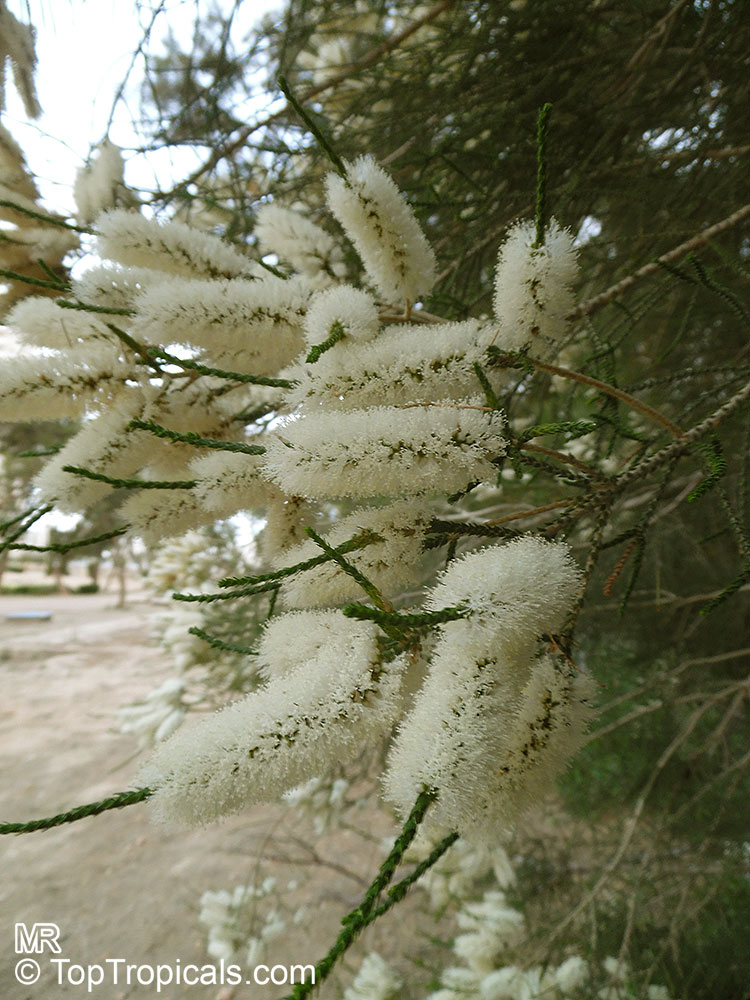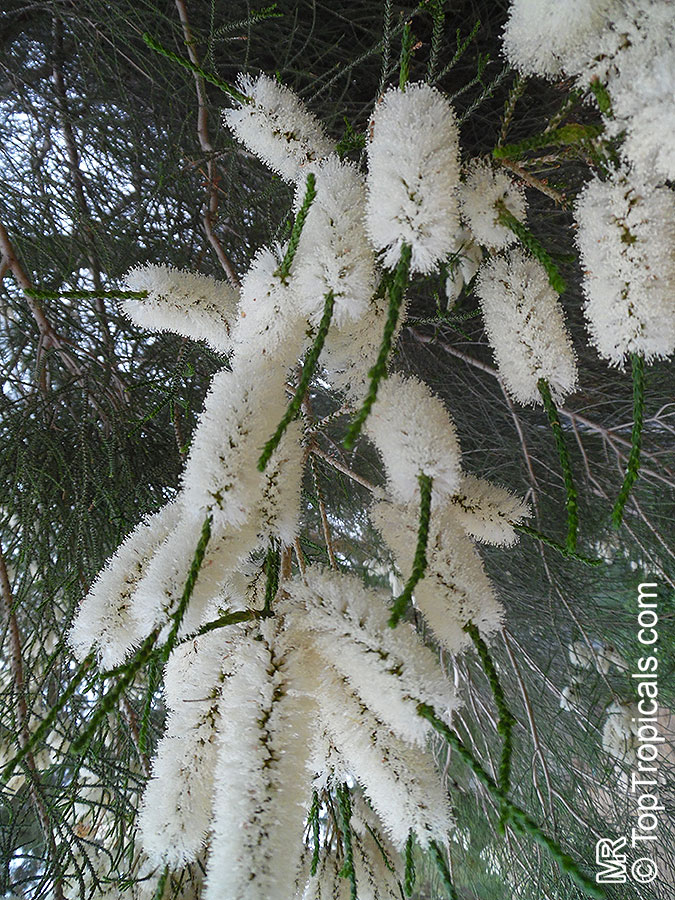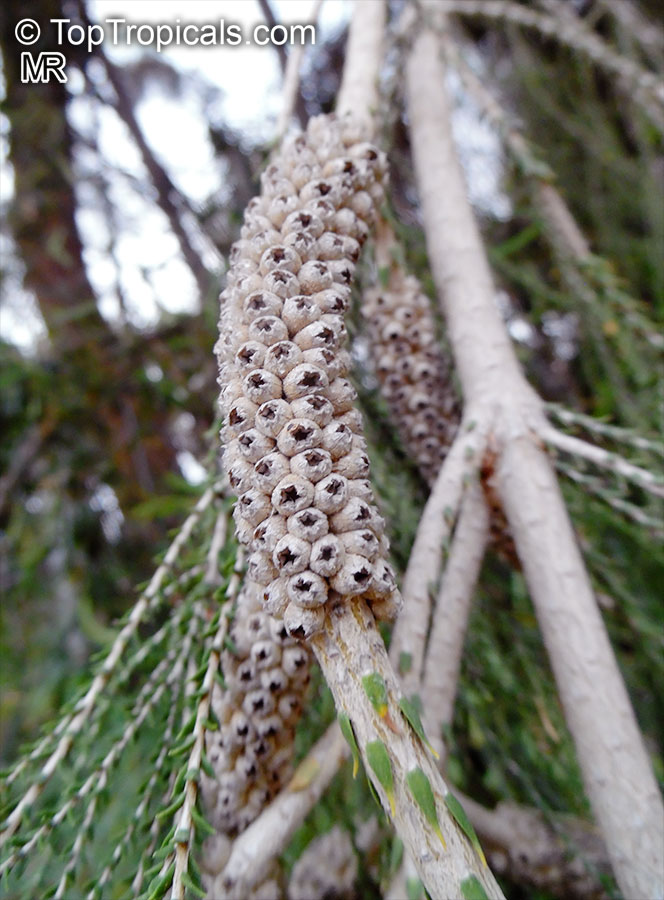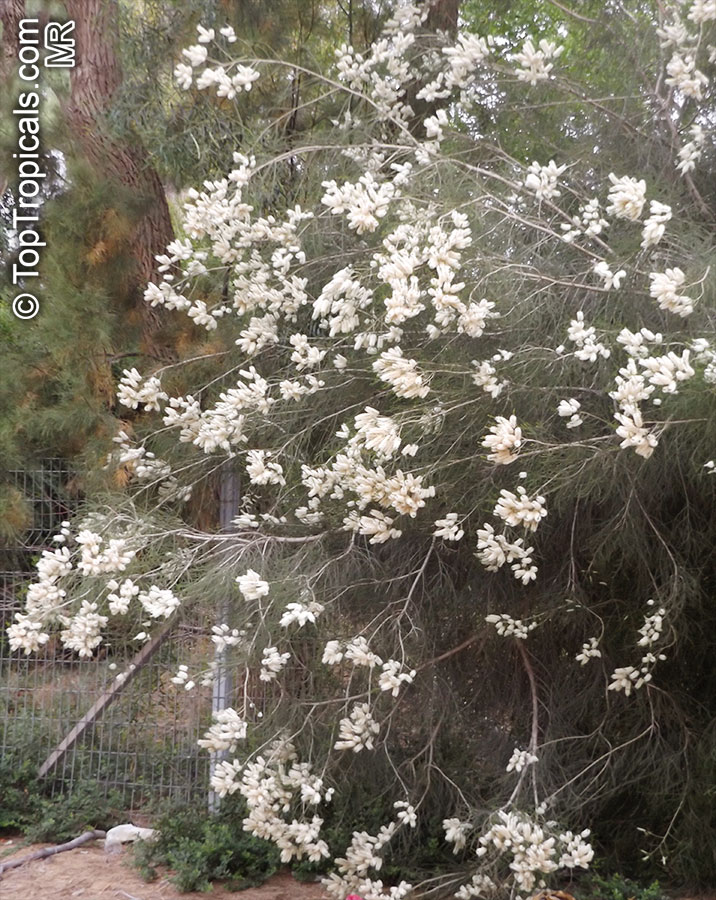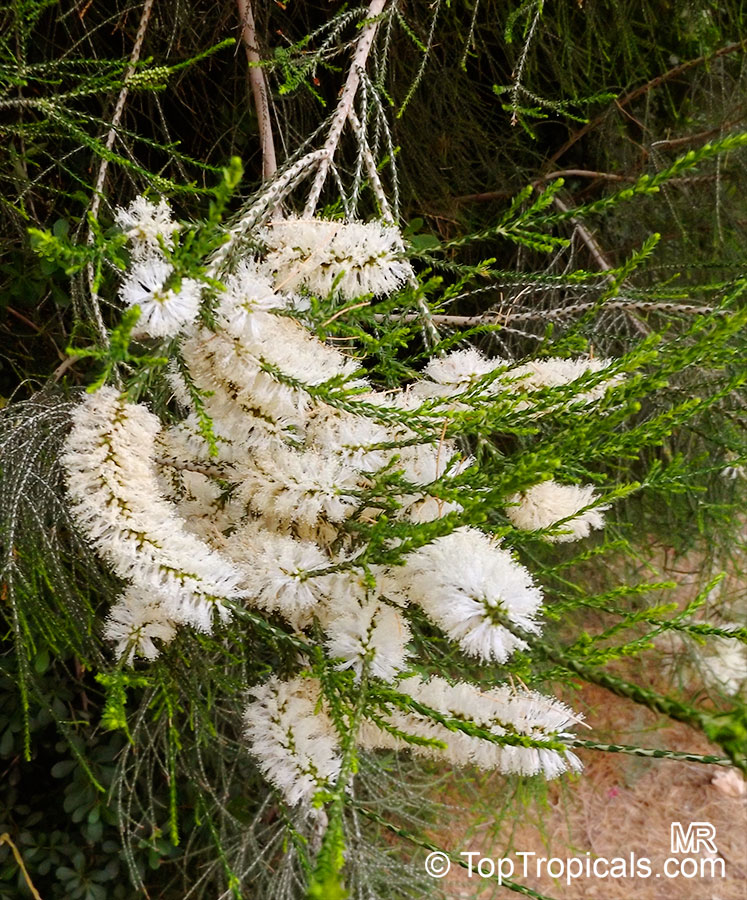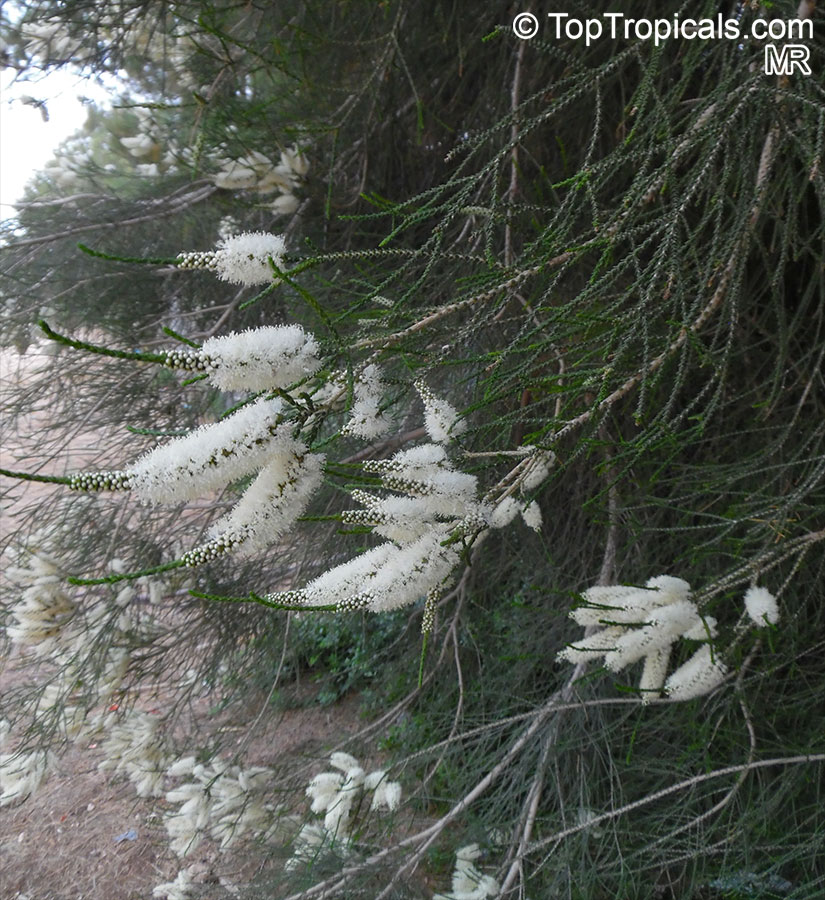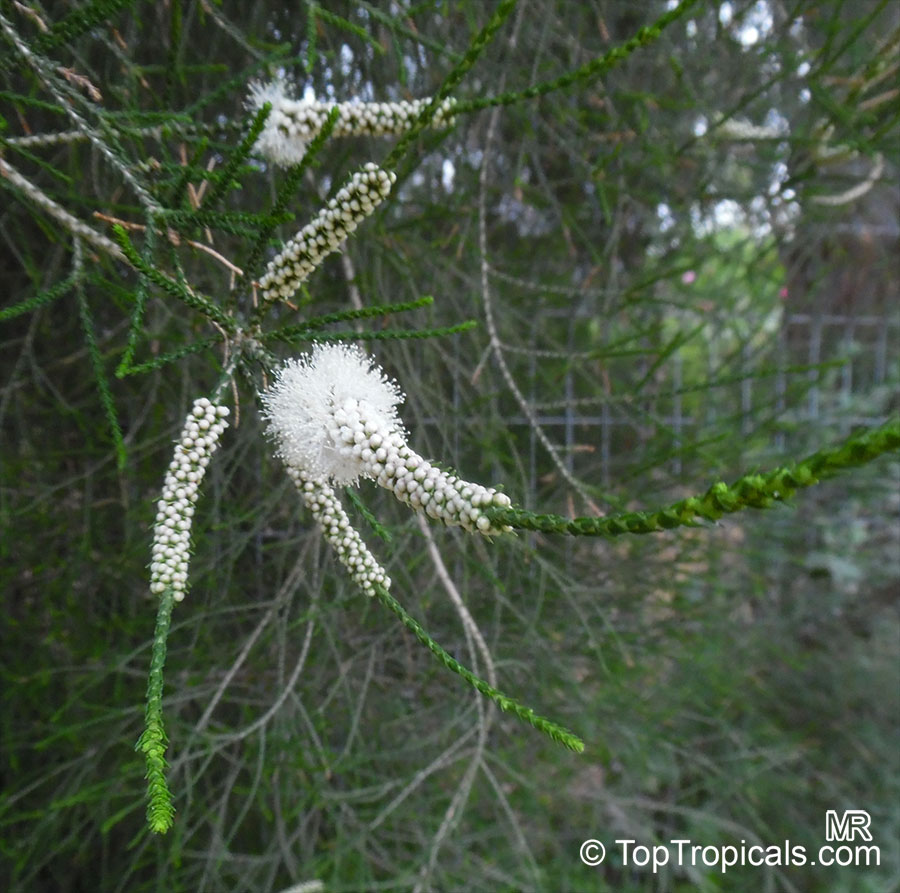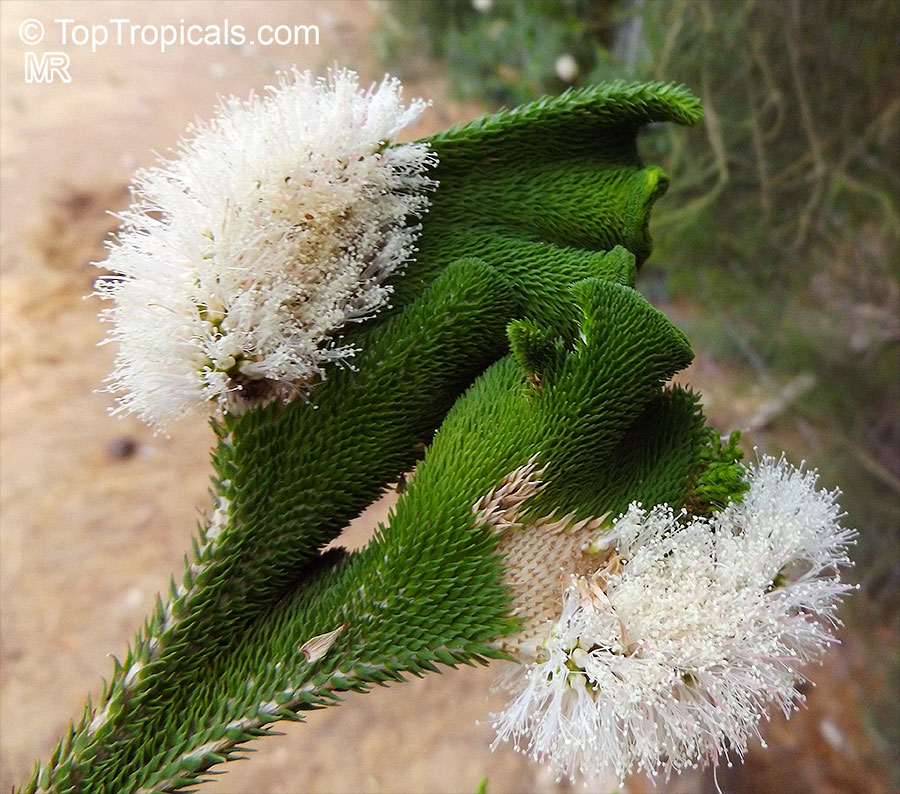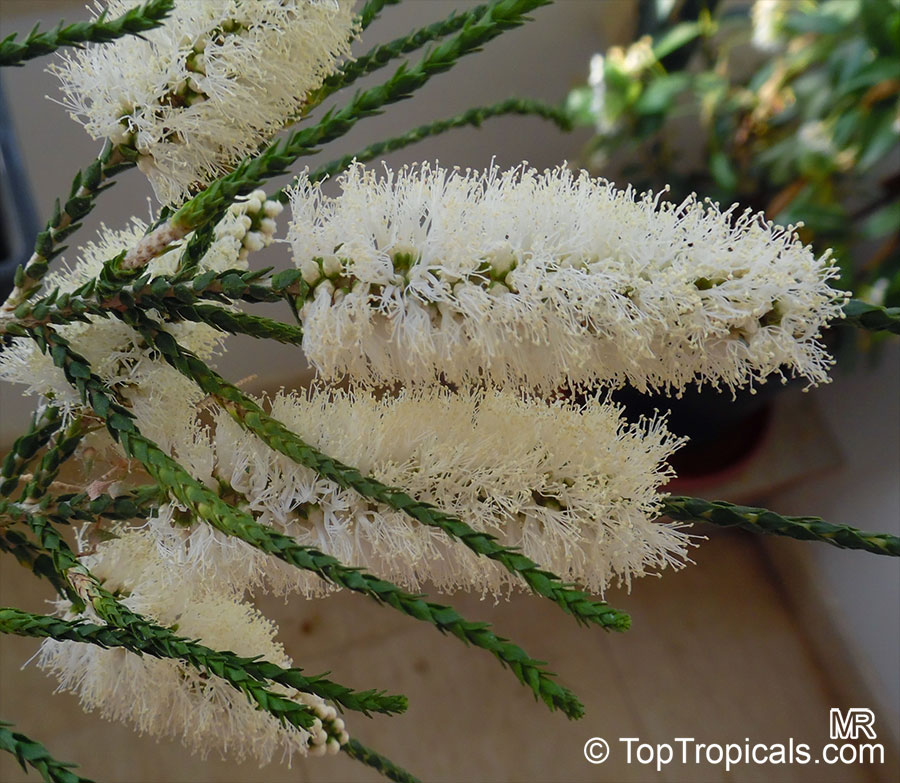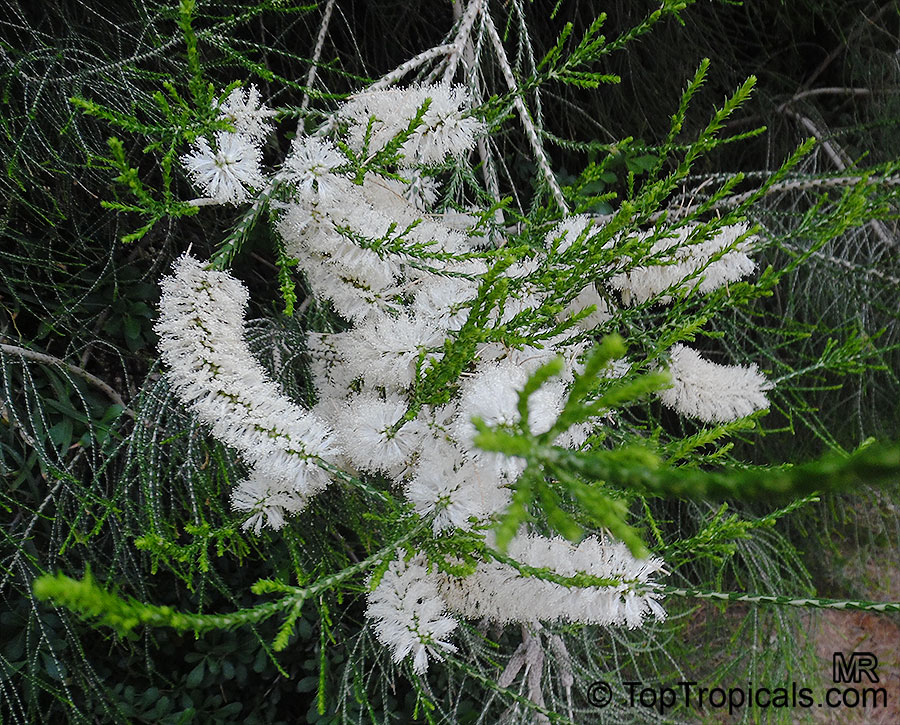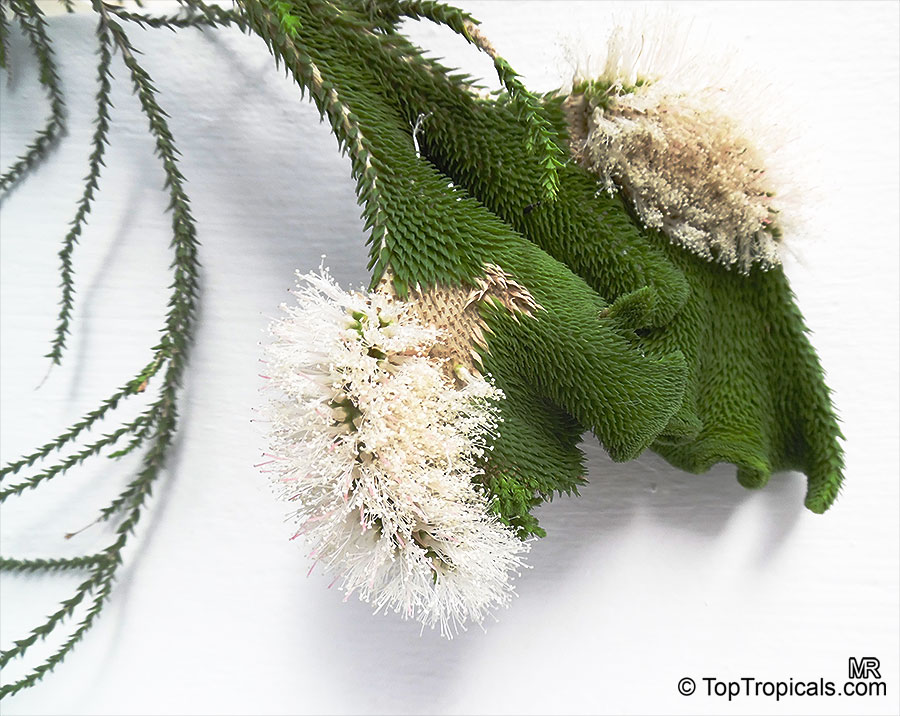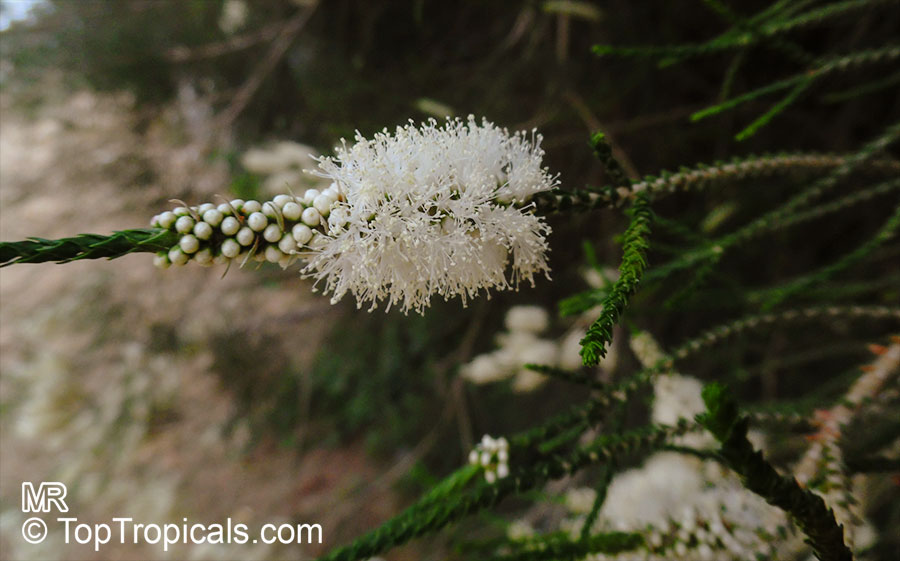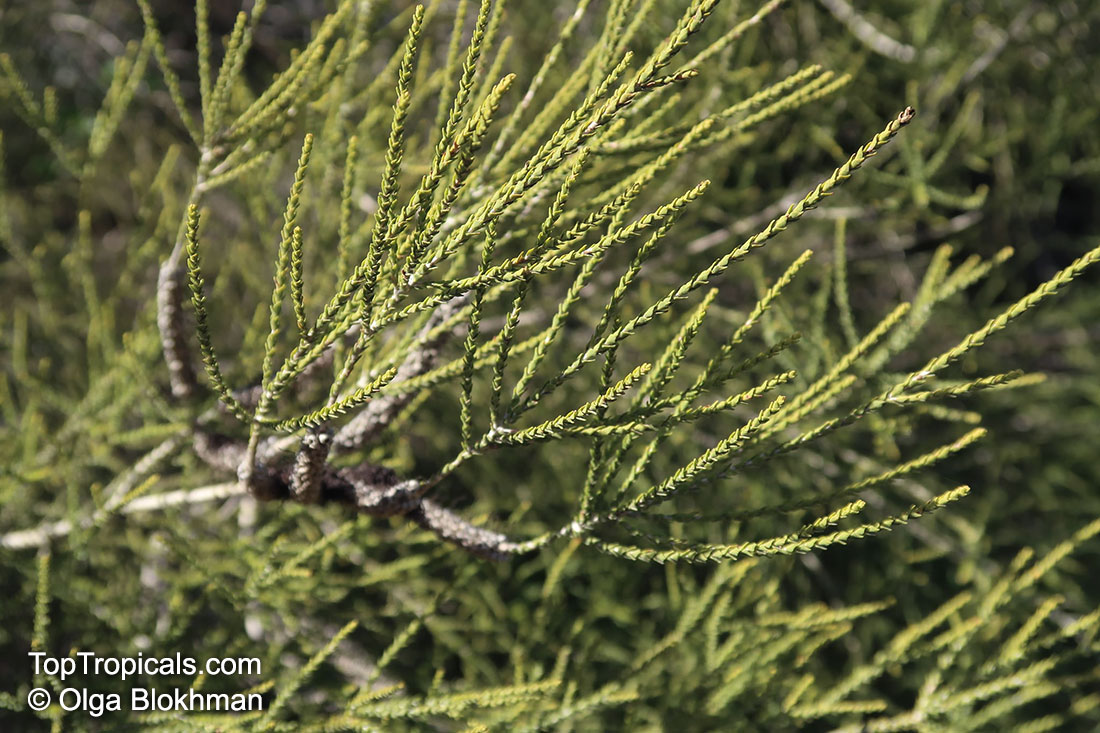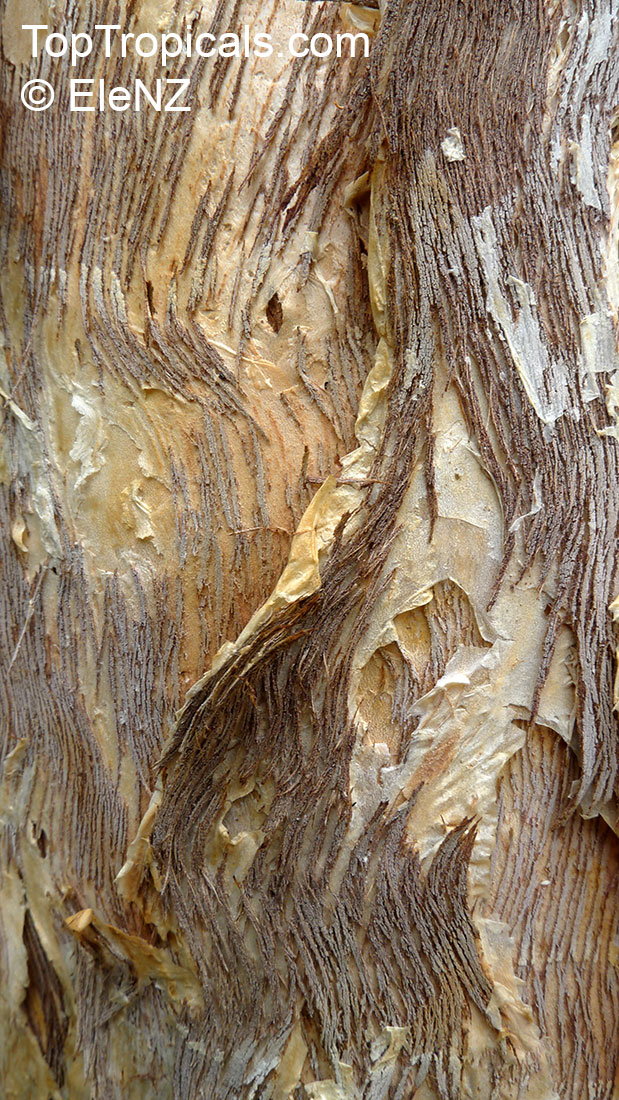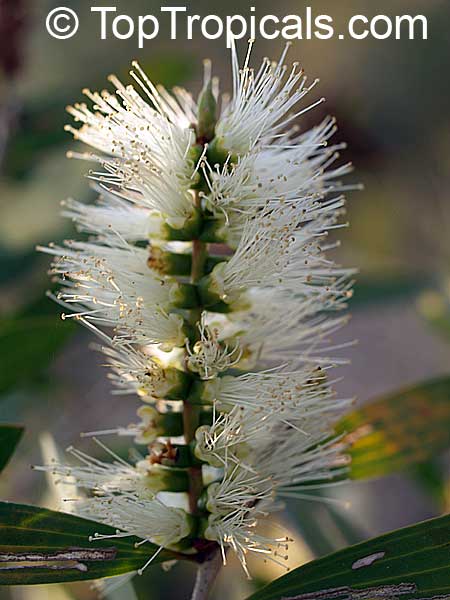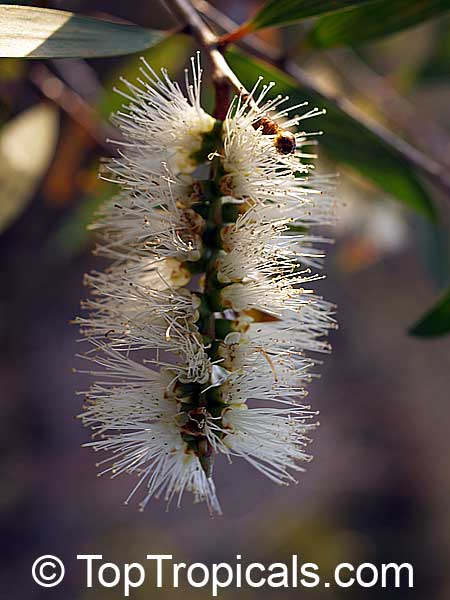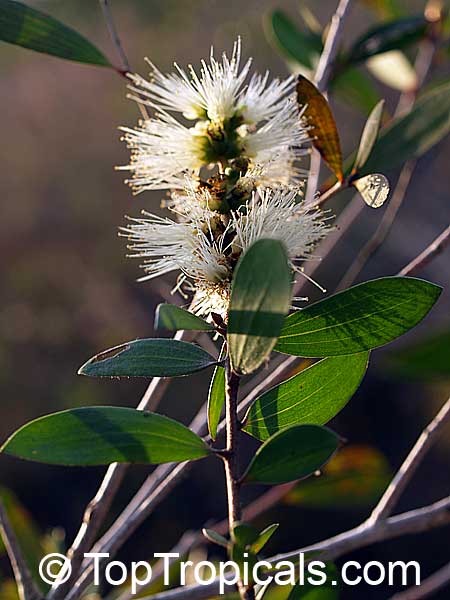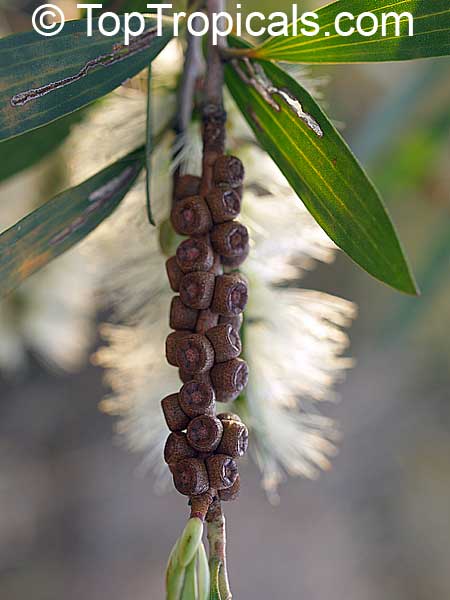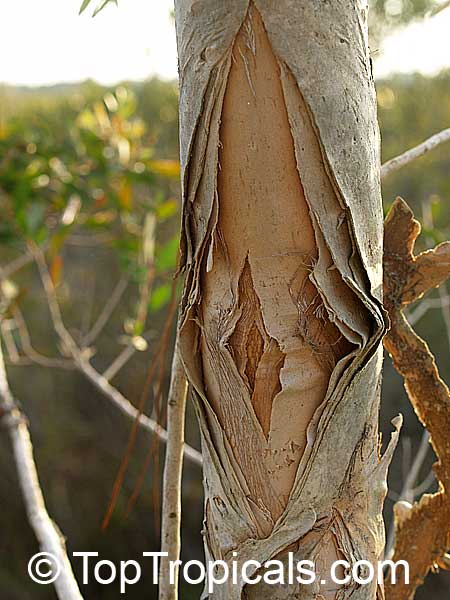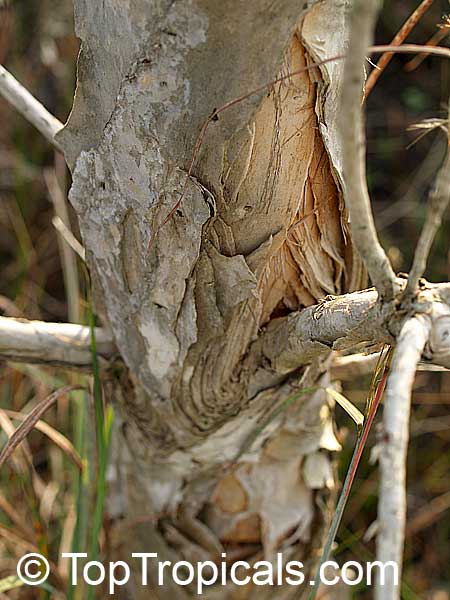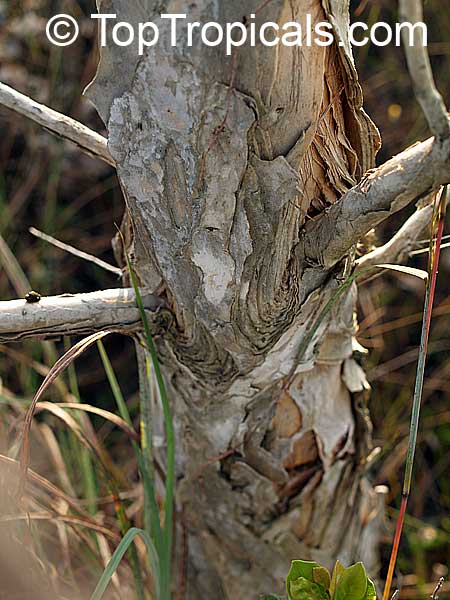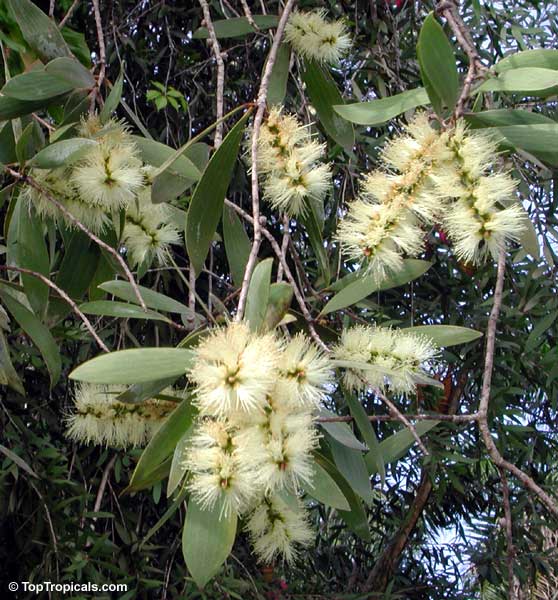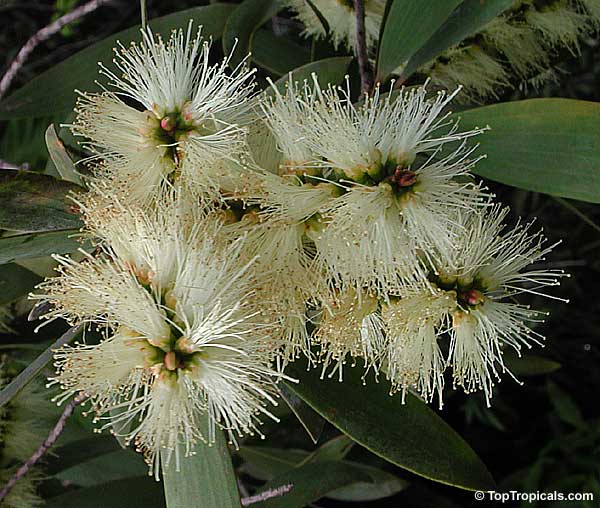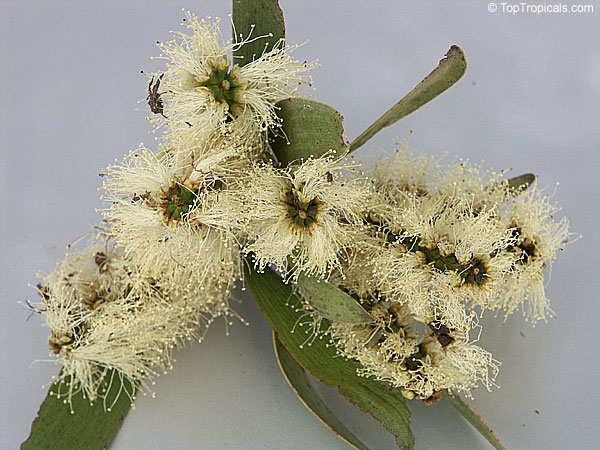Melaleuca - Plant Encyclopedia Results
Top Tropicals Plant Encyclopedia
| Number of plants found: 12 | Next | 
|
Go to page: | 1 | 2 |
Botanical name: Melaleuca alternifolia
Common names: Tea Tree, Snow-in-Summer
Family: Myrtaceae
Origin: Australia









Melaleuca alternifolia or Tea Tree is ideal for bonsai either in the ground or in a container. This species does well in a container and may be pruned to almost any shape and size. When grown in a pot, it requires moderate water in the Summer and slightly drier conditions in winter. Mature plants can handle short excursions of temperatures down to the low 30's F, but it's best to provide winter protection in regions of hard frosts. Although it can handle long dry spells, it prefers regular watering in the summer, which encourages more robust growth. For best result feed with a slow release fertilizer.
Melaleuca alternifolia is a native plant of Australia and is an evergreen shrub or small tree that can grow 5-20 ft tall. It has narrow linear leaves and produces profuse white, off-white flowers that are highly fragrant when rubbed. Tea Tree also has medicinal properties, producing an essential oil with antifungal and antibiotic properties.
Tea Tree grows best in full sun and moderately moist soils with good drainage. It is hardy in USDA Zones 9-11, but can handle short excursions of temperatures down to the low 30's F. It prefers regular watering in the summer, and slightly drier conditions in winter. For best result feed with a slow release fertilizer. It can be pruned to almost any shape, making it ideal for bonsai either in the ground or in a container. When grown in a pot, it requires moderate water in the Summer and slightly drier conditions in winter.
The Tea Tree is most famous for its essential oil, which is extracted from the leaves by steam distillation and marketed as Tea Tree Oil. This oil has anti-fungal and antibiotic properties and has a long history of use in aromatherapy. The native Australians used the therapeutic oil of this tree for a wide range of topical applications, including crushing the leaves to use as rubbing mediums and bathing in water that had collected under the trees.
In 1922, a paper was published in Australia about its wide-ranging antibacterial and antifungal activity. During World War II, Tea Tree Oil was in such short supply that all available stocks were used to treat infections in soldiers' war wounds. However, after the war, it was deemed necessary to find a cheaper, more readily available antimicrobial alternative, leading to a decline in the Tea Tree Oil industry.
In the 1990s, a scientific research team at the University of Western Australia conducted further studies on the effectiveness of Tea Tree Oil. They found that it was invaluable as a topical disinfectant for treating a strain of staphylococcus that had evolved to resist many synthesized antibacterial medicines. Tea Tree Oil has been used as a complementary therapy in surgery, burn care, and dental care, and is also used in a variety of body care products, including soap, shampoo, toothpaste, lip balm, topical cream, and essential oil.
Botanical name: Melaleuca armillaris
Common name: Bracelet Honey Myrtle
Family: Myrtaceae
Origin: South Australia








Melaleuca armillaris is a large shrub or small tree that grows to a height of 5-10 feet and is native to South Australia. Its white and off-white flowers attract butterflies and hummingbirds. It is known for being quite salt and drought tolerant, making it an excellent choice for landscaping and seaside communities. When planted in the correct conditions, they can produce a spectacular show of flowers throughout the growing season.
Melaleuca armillaris is an evergreen species with attractive dark, dense foliage and attractive peeling bark. It prefers full sun and moderate water. In cooler regions, it can be grown in a pot or container. It is best to water it deeply during hot summer months, yet avoid at the same time from overwatering. A fertilizer high in nitrogen should also be added to promote leafy foliage growth. Trimming and pruning should be done during the summer months to encourage bushier growth.
This fast-growing shrub can survive in many different conditions and is hardy in the USDA Zone of 9-11. It is an excellent choice for areas where a low growing shrub is required in order to provide privacy and screening. When planted in a sunny garden, it will ensure all-season foliage and spectacular flower display. The pink and white flowers will add to the colorful and beautiful environment of any garden.
Botanical names: Melaleuca cajuputi, Melaleuca leucadendron
Common names: Cajuput Tree, Swamp Tea-tree
Family: Myrtaceae
Origin: Indonesia





Evergreen shrub or usually single-stemmed tree with an extensive root system, sometimes with aerial adventitious roots. Bark layered, fibrous and papery, grey to white.
Within the complex, M. cajuputi is most closely related to M. viridiflora and M. quinquenervia. M. quinquenervia is like M. cajuputi but its old leaves are not conspicuously dotted with glands, not thin-textured and have obscure reticulations.
Botanical names: Melaleuca citrina, Callistemon citrinus, Callistemon lanceolatus
Common names: Common Red Bottlebrush, Crimson Bottlebrush, Lemon Bottlebrush
Family: Myrtaceae
Origin: Australia






Medium size tree with arching or weeping stems and showy bright red flowers. Cold tolerant, drought resistant. Fast growing, great solution for privacy planting.
Learn more: How to grow Bottle brush trees.
Learn more: How to grow Bottle brush trees.
Recommended Fertilizer: SUNSHINE Megaflor - Bloom Nutrition Booster
Botanical names: Melaleuca cuticularis, Melaleuca abietina
Common name: Saltwater Paperbark
Family: Myrtaceae
Origin: Western Australia








Melaleuca cuticularis is an excellent choice for bonsai due to its unique bark and impressive profile. It grows slowly over time, making it easy to maintain and shape. It matures to a small tree of 10-20 feet in height, with an equally wide spread. The off-white flowers are an attractive adornment, and its oval ornamental foliage provides contrast and interest.
Melaleuca cuticularis is ideally suited to USDA Zones 9 through 11, and is tolerable of both seaside sites and salt environment. This makes it an incredibly versatile choice, allowing it to be grown practically anywhere along the US coast. It is also able to survive temperatures as low as the mid-30s F, though only for a brief period, and so may be suitable as a specimen in colder climates.
For successful cultivation, Melaleuca cuticularis should be placed in full sun or semi-shade and watered moderately, but with extra attention in the summer months. If growing in a pot for colder regions, it is important to bring the pot inside for winter and to ensure the soil is well-draining to avoid root rot. Repot the plant annually and use a high-quality soil mix. If you are watering from underneath, avoid standing water in the saucer.
Botanical name: Melaleuca decussata
Common names: Cross-leaved Honey-myrtle, Totem Poles
Family: Myrtaceae
Origin: Australia








Native to Australia, Melaleuca decussata brings a variety of wildlife to your garden as it is known to attract butterflies, bees and hummingbirds. This large-sized shrub will reach between 5 to 10 feet in height and can even be used to create a stunning bonsai.
Its natural habit is one of dense foliage and it grows best when given full sun or semi-shade exposure. This plant has moderate water requirements, so it should be watered regularly, but not overly saturated.
Grown in USDA Zones 4-10. When growing in a pot, it prefers well-draining soil and needs to be monitored through out the winter months. During the dormant months, water regularly and ensure the soil dries out partially between watering.
Its pink flowers are stunning accents to any garden and will keep blooming from late winter to mid-autumn. Melaleuca decussata also maintains its foliage year-round and will grow to be a low care large shrub that adds continuous beauty to any garden. This plant considered to be invasive in its native habitat.
Botanical name: Melaleuca elliptica
Common names: Granite Bottlebrush, Granite Honey Myrtle
Family: Myrtaceae
Origin: Australia








Melaleuca elliptica is a shrub with pale grey, papery bark that peels in thin strips. Its leaves are arranged in alternating pairs (decussate), each pair at right angles to the ones above and below so that there are four rows of leaves along the stems. The leaves are elliptic to egg-shaped with the ends usually rounded.
Melaleuca elliptica can withstand salt winds in dry coastal areas and makes a good screen against salt spray. It is drought and frost hardy to about 20 degrees F. once established and can hold up to salt laden winds along the coast, making it a good first exposure screen to protect other plants in beachside plantings.
Botanical name: Melaleuca ericifolia
Common names: Swamp Paperbark, Australian Rosalina
Family: Myrtaceae
Origin: Australia





Yellow or creamy white flowers that look like small bottle brushes. Dark green linear (needle-like) leaves. White bark that peels off in strips as the tree grows. Tolerances: Drought; poor drainage; any soil; salt air; gusty winds; fog. Special Considerations: Prefers sun. When planting, handle rootball with care or tree will go into transplant shock. Do not let rootball dry out during establishment period. Needs extra water in hot or windy conditions. Melaleuca ericifola - An essential oil with antiseptic and calming properties. This variety of melaleuca oil is exceptionally gentle and non-irritating to the skin and is used by the well-known essential oil.
Botanical name: Melaleuca huegelii
Common name: Chenille Honey-myrtle
Family: Myrtaceae
Origin: Australia






Botanical name: Melaleuca quinquenervia
Common names: Paperbark, Honey Myrtle, Punk Tree
Family: Myrtaceae
Origin: Australia










In contrast with its relative, a valuable Tea Tree, this Melaleuca has rather disturbing story. Being a tough plant, tolerating both standing water or dry upland situations, Melaleuca quinquenervia was introduced in Hawaii and the Florida Everglades, in order to help drain low-lying swampy areas. It has since gone on to become an invasive weed with potentially very serious consequences being that the plants are highly flammable and spread aggressively.
Melaleuca quinquenervia is an evergreen tree with a slender crown and drooping branches. Melaleuca grows very fast, up to 6 ft per year, and produces dense stands that completely shade out all other vegetation. It usually gets about 40 ft tall, but can get up to 100 ft if conditions are favorable. The bark is whitish and spongy, peeling off in thin layers. The leaves smell like camphor when bruised. The flowers are creamy white and arranged in "bottle brush" spikes; they are followed by fruit - small woody capsules, each containing several hundred tiny seeds, dispersed then by wind and water. A single tree that starts blooming when two year old, can produce 20 million seeds per year. The seeds are stored until some form of stress, such as frost, fire or human- induced injury, including herbicide, causes the capsules to open. The plant re-sprouts from cut stumps and from roots of fire-killed trees. Mature melaleuca trees survived Florida record-breaking freezes. Freezing is yet another environmental stress factor known to trigger mass seed release.
In Southern Florida, Melaleuca occupies now several million acres, primarily within the Everglades system. Its populations have nearly quadrupled over the past decade, it has become one of the state's worst invasive weeds and represents a severe threat to the integrity of the Florida Everglades. Melaleuca was introduced into Florida in 1906 as an ornamental and widely planted for landscaping and for "swamp drying." Seeds were scattered from airplanes over the Everglades in the 1930's in an attempt to create forests and drain the swamp. Even as late as the 1960's, Melaleuca was still being recommended as an ornamental. Today, state and federal agencies are actively working to control the spread of this exotic menace. Biological control agents from Australia have been released. Crews are at work continuously cutting and herbiciding melaleuca trees in state parks, Everglades National Park and Big Cypress National Preserve.
Melaleuca quinquenervia is similar to Melaleuca cajuputi but its old leaves are not conspicuously dotted with glands, not thin-textured and have obscure reticulations.
| Next |  |
Use link to repeat this search:
https://toptropicals.com/cgi-bin/garden_catalog/cat.cgi?find=Melaleuca&search_op=and&keyword_op=and&language=e&number=10
&no_change_lang=1&user=tt&sale=1&first=0
